6+6+6: In celebration of Easter, here are 18 must see films that explore the crossroads of religion and horror, and often the distinct merging of the two.
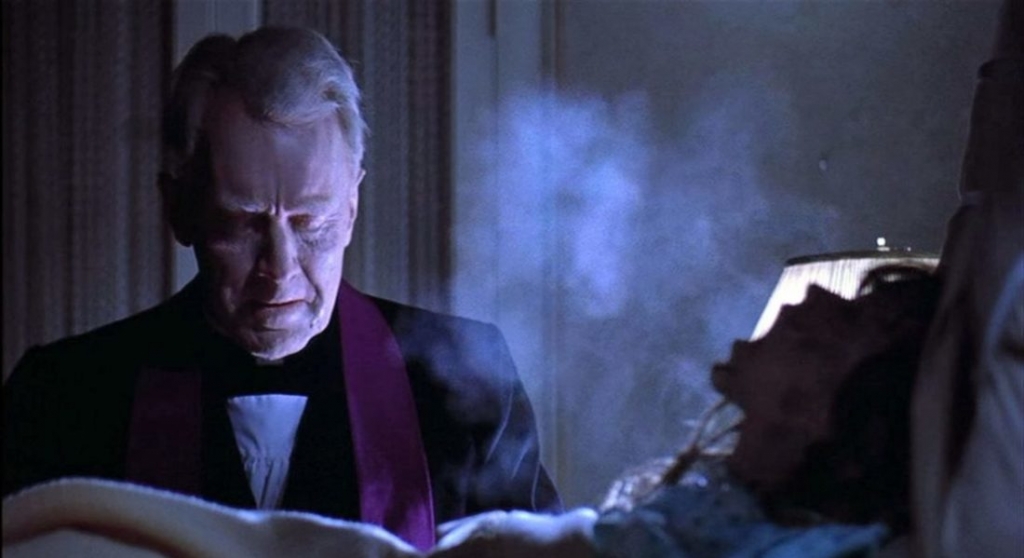
“I think the point is to make us despair, to see ourselves as animal and ugly. To make us reject the possibility that God could love us.” – Father Merrin, The Exorcist
Intro by Matthew Currie Holmes
When discussing religion in horror, the first movie that comes to everyones mind, almost immediately is William Friedkin’s 1973 masterpiece The Exorcist. It is not only the archetype but also the aspiration for all other religious themed horror films. It’s been 46 years and this behemoth still reigns supreme both in quality of scares and masterful filmmaking. No other film on this great list holds a candle to The Exorcist, and every one of them owes their very existence to it.
That’s not to say there are not sublime movies on this list. On the contrary, I would argue that every single film mentioned below is worthy of repeat viewing and, I am happy to state that most of these movies have been enjoyed more than once by yours truly. I should also confess, I have not seen every film listed below, and that thrills me to know that, based on the effusive praise bestowed upon them, I will be discovering some knockouts.
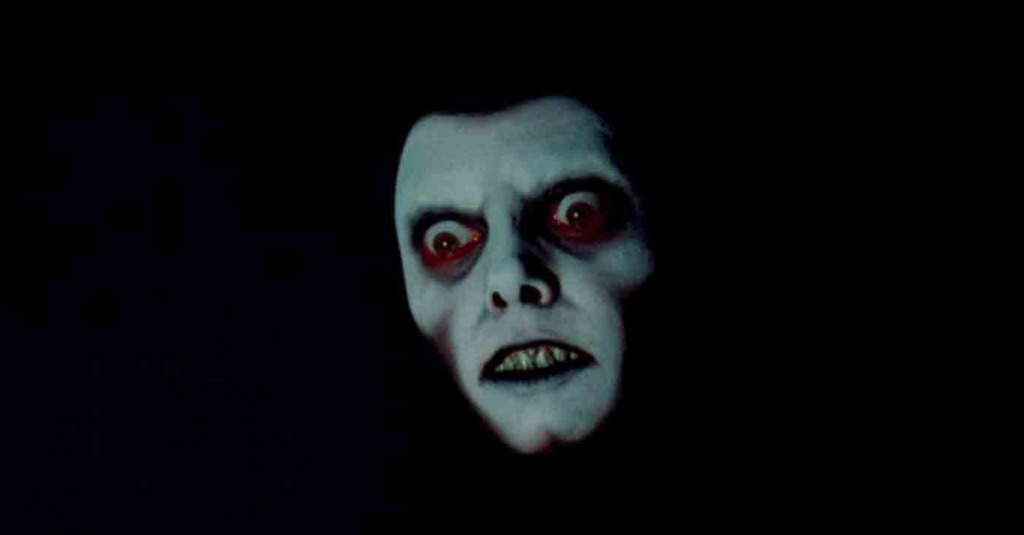
While it is clearly evident that The Exorcist is absent from this list, it should be stated that was by design.
The Exorcist is seminal and has been written about countless times by countless poets, authors, film historians, film prognosticators, critics, analysts and fans. In short, everything that could possibly be written about The Exorcist has been. We at Morbidly Beautiful wanted to highlight religious-themed movies that, in some instances, were lesser known — and in others, the allegory may be a little more hidden in the subtext. These are films meant to be discovered or revisited.
The final reason The Exorcist was omitted from the list below is because it is sitting up here, above all others, right where it belongs.
…
FIRST 6
THE WITCH, THE CONJURING, THE OMEN, FRAILTY, THE GOLEM, THE WICKER MAN
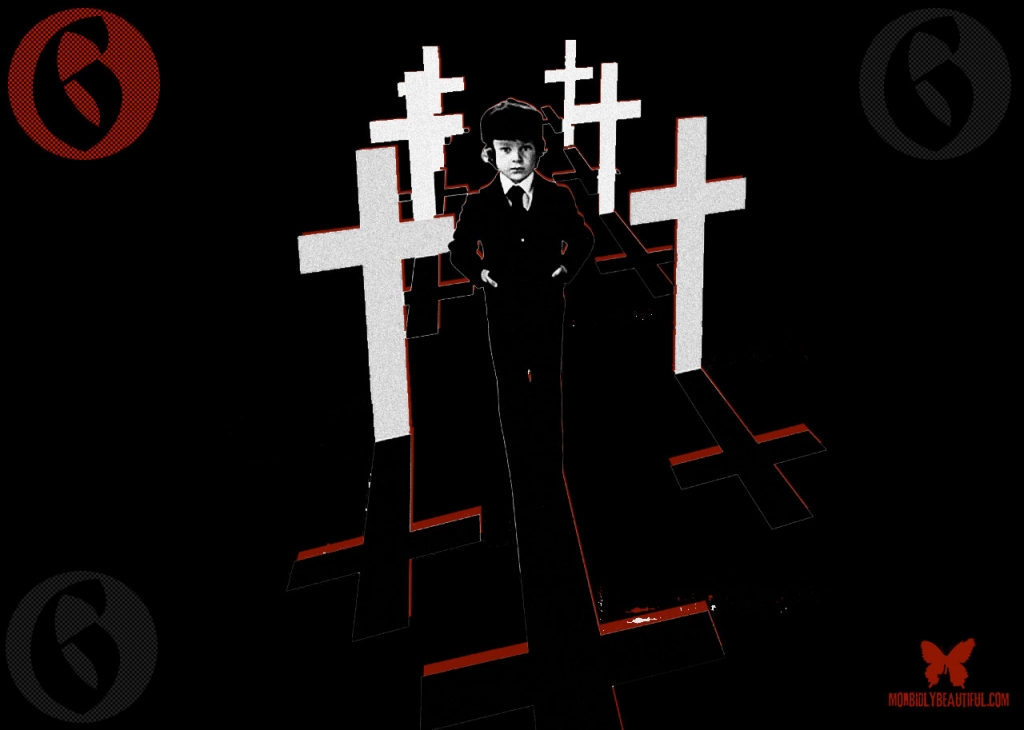
“There is no devil, there is no God– there is only here and now and life.” – The Omen
THE WITCH (2015)
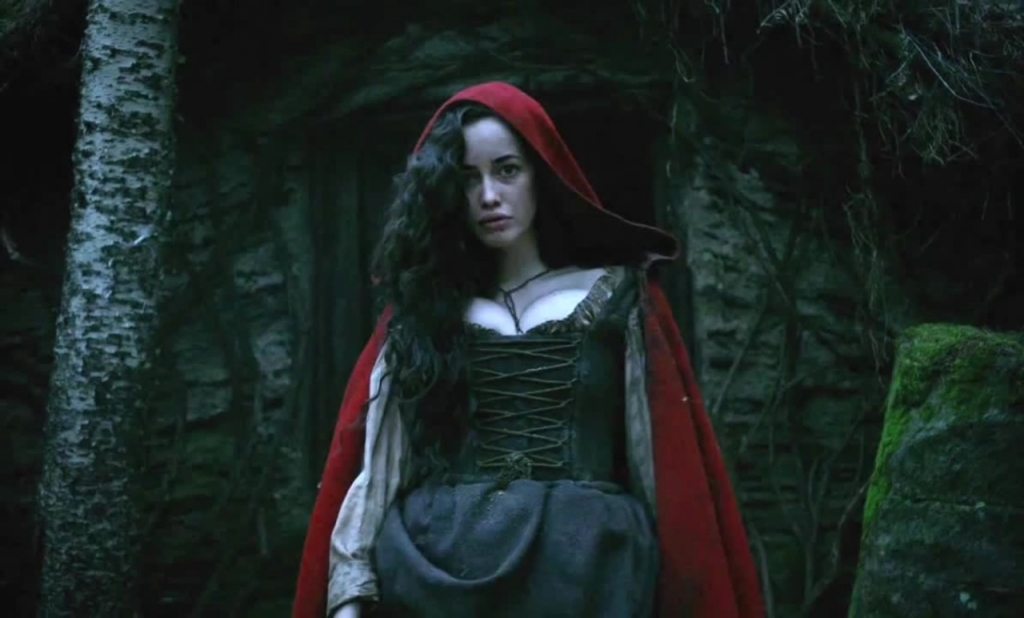
Recommended by Syd Richardson
There’s a lot to be said about what’s found at the intersection of religion and horror, and no other film explores these two themes better than Robert Eggars’ 2015 release, The Witch.
Following a dispute within their Puritan colony, a family of six are banished, and find a new home on the outskirts of a New England forest. Before long, the family — including William, his wife Catherine, eldest daughter Thomasin, son Caleb and twins Mercy and Jonas — find themselves falling victim to the things that lay in the woods, seeking to destroy their faith and, ultimately, their lives.
Religion (invoking the Holy Trinity here) plays three key roles in Eggers’ film: catalyst, savior, and villain.
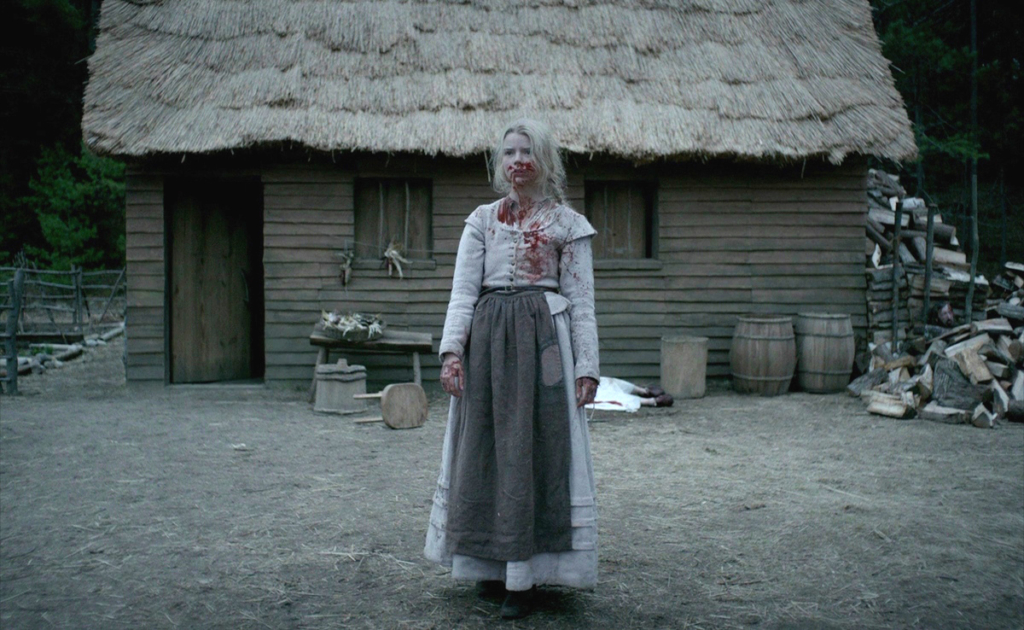
By preaching what he believes to be the true gospel, William and his family are ostracized from the church, effectively making religion a catalyst for the unfortunate series of events to come.
Religion as savior: Thomasin invokes her faith against her sibling’s accusations that she is a witch, proclaiming her love for the lord and His word. Religion is where Katherine turns, after the baby is stolen, for some small measure of comfort that her husband cannot give her.
And, when wielded by William, religion is the family’s downfall. Though he manages to justify his banishment under the guise of devotion, he puts his family directly in harm’s way. It is the family’s puritanical upbringing that quickly gives rise to mistrust, and discord, effectively breaking them apart as a unit.
By the time the madness dies down, and Thomasin is the only one left standing, it doesn’t take much for her to sign the devil’s book, effectively forfeiting her soul.
Her actions in the finale raise a couple of questions.

Was Thomasin as secure in her faith as we are led to believe in the beginning? The puritanical society of the 1600s didn’t afford women much freedom. Thomasin showed throughout the film that she was a headstrong young woman. Perhaps Thomasin knew what was waiting for her, should she lick her wounds and head back to town: a life of complete servitude, at best, or perhaps being tried and hanged as a witch for her family’s disappearance.
Or was it a matter of the devil breaking Thomasin down by having her doubt her own faith and stealing her family away from her, ultimately forcing her to join him?
Either way, the film ends with a haunting shot of Thomasin floating with the other witches of the woods. We can’t tell if she’s cackling in laughter reserved only for the mad, or if she’s found genuine freedom after being released from her Puritan lifestyle. But I think that mystery is part of the allure of The Witch, and what makes it such a memorable and effective film.
THE CONJURING (2013)
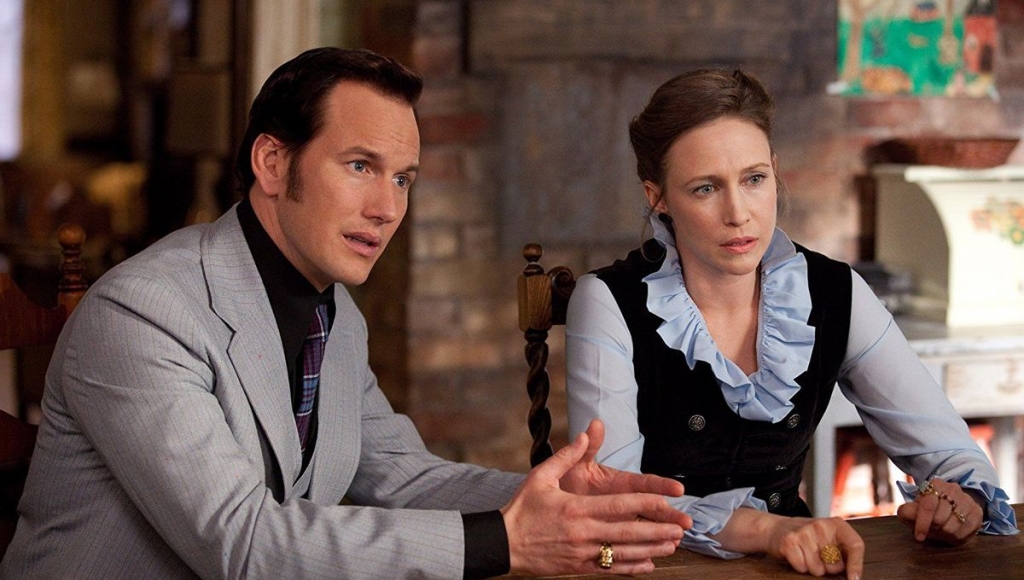
Recommended by Jamie Alvey
We Catholics are known for being one of the more morbid branches of Christianity. After all, we do love graphic depictions of the Crucifixion in our churches, the Stations of the Cross, vengeful angels with multiple eyes, and so on. When you think about Catholicism in horror, The Exorcist certainly comes to mind. It is the poster child for Catholic-tinged horror. However, The Conjuring series that James Wan brought forth is the heir apparent to the throne.
The Conjuring films follow a fictionalized version of real life demonologists Ed and Lorraine Warren (played by Patrick Wilson and Vera Farmiga).
Lorraine is the centerpiece of the film, as she’s more religious than her husband. Lorraine is spiritual and straddles the line between this world and the next. She is open about her struggles coming to terms with her psychic-medium abilities, as well as how her faith gave her purpose and direction when it comes to using those talents.
Farmiga gives Lorraine a warm and serene quality, a woman that embodies all the Christ-like love one would hope a devout follower of God to exemplify.

Her reasons for pursuing the unknown and unholy is rooted deeply in aiding others. She is presented as both gentle and fierce. Her ferocity and tenacity is a direct result of what she views as her call to duty from God; even the face of great evil she doesn’t give up. She’s often terrified by the supernatural around her, but her faith does not waver.
At Lorraine’s side is Ed Warren. He shares Lorraine’s faithfulness, but he lacks a deeper understanding of it. Although he puts his trust completely in Lorraine and her abilities, he often worries for her well-being since she is often in direct contact with the supernatural. Ed encompasses the idea of blind faith, and his reverence and belief in Lorraine mirrors his reverence and belief in God.
James Wan gives us characters that represent unfettered love and belief, which Christians should typically strive for. Unlike some religious horror films, The Conjuring portrays religious faith as a powerful weapon against evil, rather than the source of evil itself.
THE OMEN (1976)
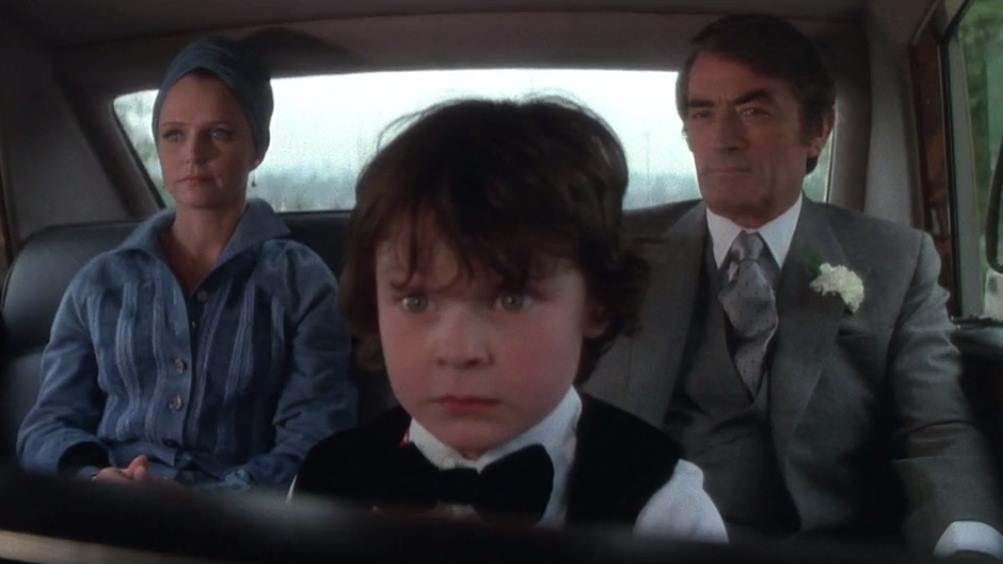
Recommended by Megan Hopkin
Undeniably iconic, The Omen enjoys a cult following that extends across generations. The story is simple: affluent politician and wife expect baby; baby dies, baby is swapped in secret; swapped baby turns out to be the antichrist and systematically kills any and all who stand in his way to world domination.
The religious undercurrents are obvious; the film is a love letter to gothic architecture, fire and brimstone Catholicism, and the threat of the final reckoning.
Father Brennan, played by Patrick Troughton, specifically embodies the duplicity between religion and human desire.
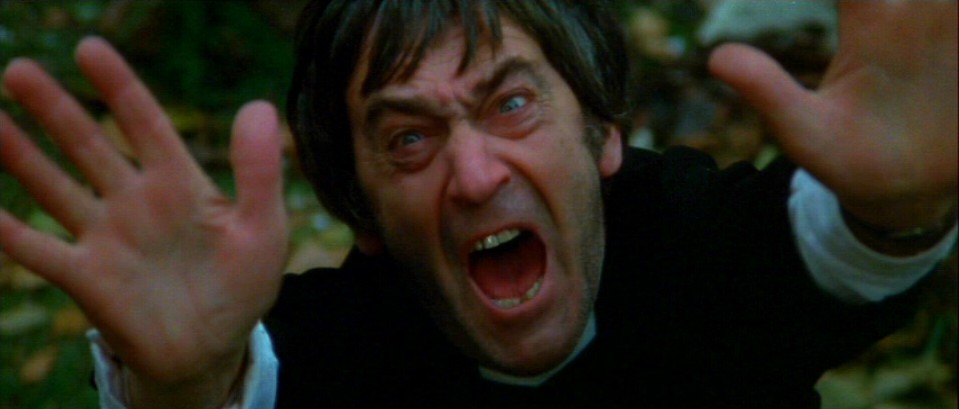
From a young age, Brennan was beaten to encourage devotion to god. On a mission to Africa, he attempts to convert a boy to Catholicism through the same means, while also exploring a lustful relationship with him. Following the discovery of this, Brennan turned to a faith which embraced his ‘sinful’ actions: Satanism.
It’s only in his dying days that Brennan attempts to atone through warning Robert Thorn (played by Gregory Peck) of the dangers of his son. Attempting to convince Thorn to kill Damien — very sacrificially I might add —definitely invokes images of Isaac and Abraham, as Abraham is ordered by God to kill his own son as a sign of devotion.
Brennan’s death is highly symbolic. It is the church that kills him in the end, via a very unfortunate lightning rod impaling. Brutal murder aside, Unfortunate Lightning Rod Impaling is definitely the new name of my imaginary metal band.
It’s also no coincidence that religion and politics are closely linked throughout the film, making for a very interesting message about the government.
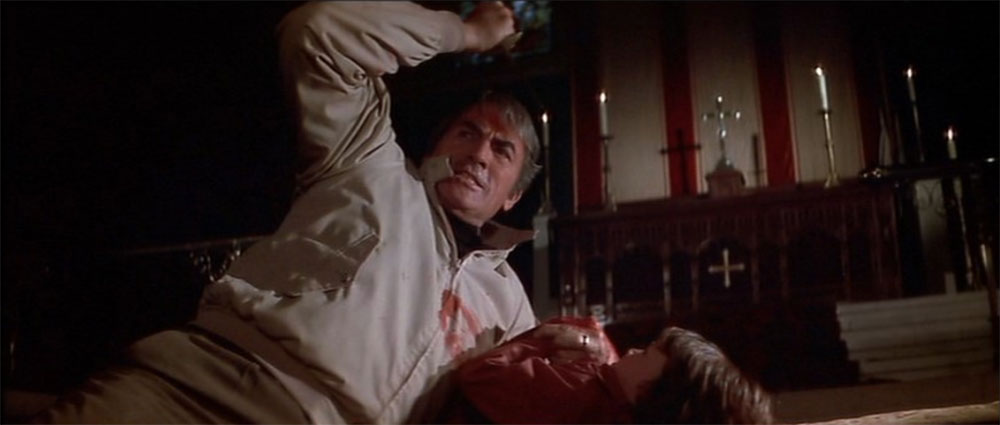
The religious element to The Omen extends past the movie however, as mysterious events around its filming led many to believe a higher power was displeased with the curation.
Gregory Peck’s son, Jonathan, committed suicide during filming, planes carrying actors and writers were struck with lightning, and another charter plane that had to be swapped last minute crashed and killed everyone on board. There was also a fatal car accident, with special effects supervisor John Richardson and his wife Liz Moore, involved. Richardson emerged alive, but Moore was decapitated. Eerily, Richardson had been the one involved with the infamous beheading scene.
The Omen is my pick as one of the big hitters in Religious horror.
FRAILTY (2001)
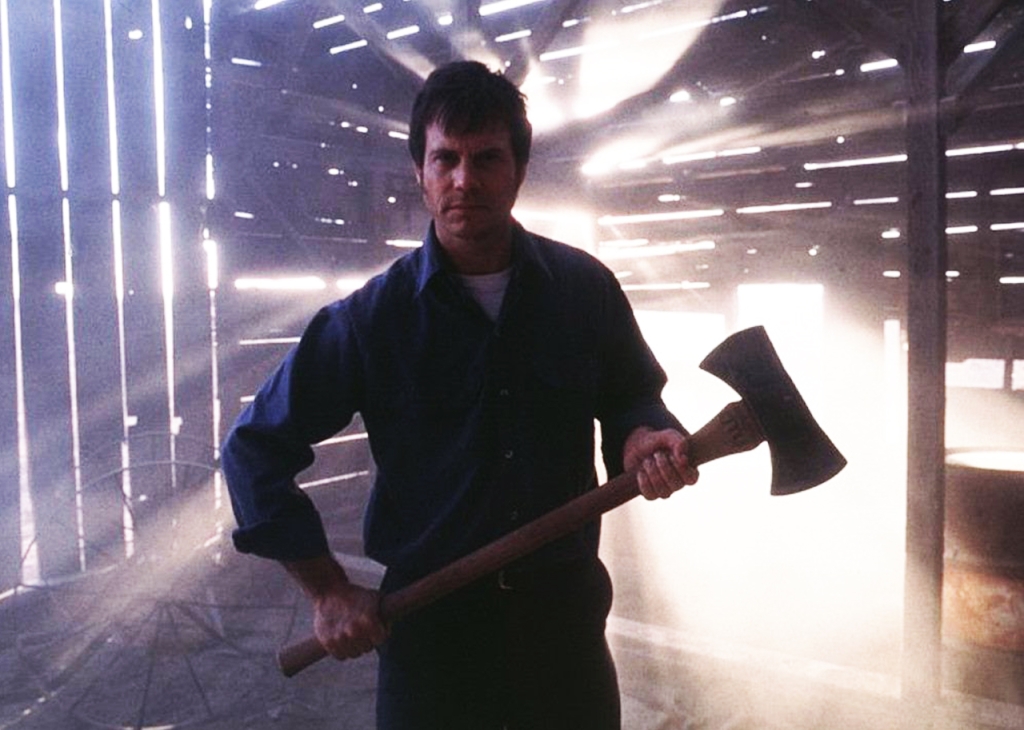
Recommended by Jackie Ruth
The 2001 psychological thriller and crime drama Frailty isn’t just underrated as a religious horror film; it’s underrated as a film, without qualifiers. It’s one of the great works of the late Bill Paxton’s career, as he both directed and starred in it.
Frailty follows the Meiks family, led by Paxton’s patriarch, who has two sons, Fenton (Matt O’Leary) and Adam (Jeremy Sumpter). It flips back and forth between the past, when the boys were young, and the present, when an adult Fenton (Matthew McConaughey) comes to the FBI with some information about a series of murders.
It doesn’t sound particularly religious, right? Well, that mostly comes from the timeline when Paxton’s character was raising the boys. You see, he had a clear message from God that there were demons in the world, and that he and the boys needed to rid the world of these demons — via murder. The wrench in the plan comes from Fenton becoming skeptical. The demons, after all, look like everyday human beings, which would make his father a murderer, not the left hand of God.
A lot of horror films that use religion lean on Catholicism (fair; it gets pretty scary), but there is a different kind of Christianity represented in Frailty.
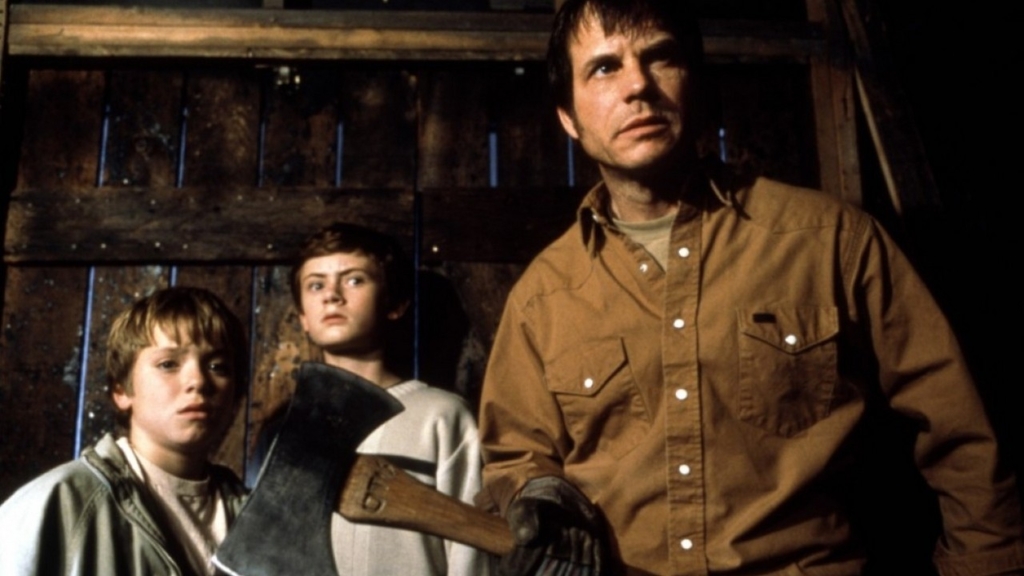
This film is, at times, uncomfortable to watch. Between the way the Meiks father treats his sons and the way he treats the alleged demons, you wonder if he isn’t really just a violent psychopath, using religion as an excuse and an outlet. The psychological aspects of this narrative will keep you guessing about the film’s true meaning up until the end (or at least near it).
If, like myself, you’re skeptical of people as fanatically religious as the Meiks, then Frailty will hit home. You may even make feel vindicated, and it might get you to question all kinds of beliefs.
That’s what makes this such a standout movie, and why it’s one of the early 2000s horror films that actually gained a fair bit of critical acclaim. Whether or not the critical reception matters to you, there’s no denying that it has an impact on how a film is viewed more widely.
If you haven’t had the chance to see Frailty, I recommend you watch it while you’re staying at home — it is a real treat.
THE GOLEM (2018)
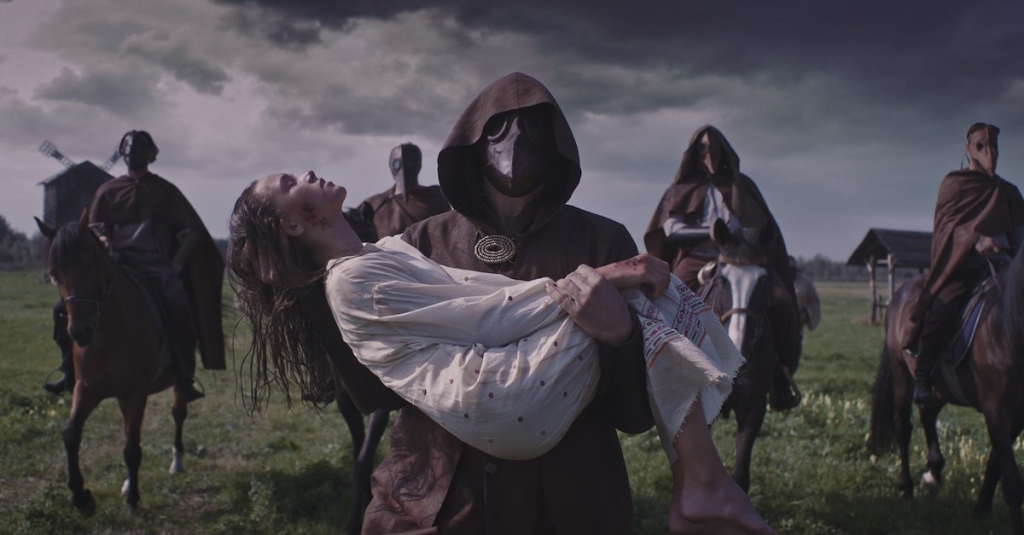
Recommended by Lizzy VB
Starting with Paul Wegener’s eponymous 1915 film, one of the first stories ever to be adapted into a motion picture trilogy was the legendary tale of the golem. Not to be confused with JRR Tolkien’s cave-dwelling ring enthusiast, Gollum, a golem is a recurring figure in Jewish folklore, generally a supernatural being molded from earth and brought to life to do its creator’s bidding.
In 2018, the story was given another interpretation by Israeli filmmakers Doron and Yoav Paz in The Golem.
The film delves not only into the familiar folktale, but also explores how the mythology relates to themes of ethics, persecution, gender roles, and choice.
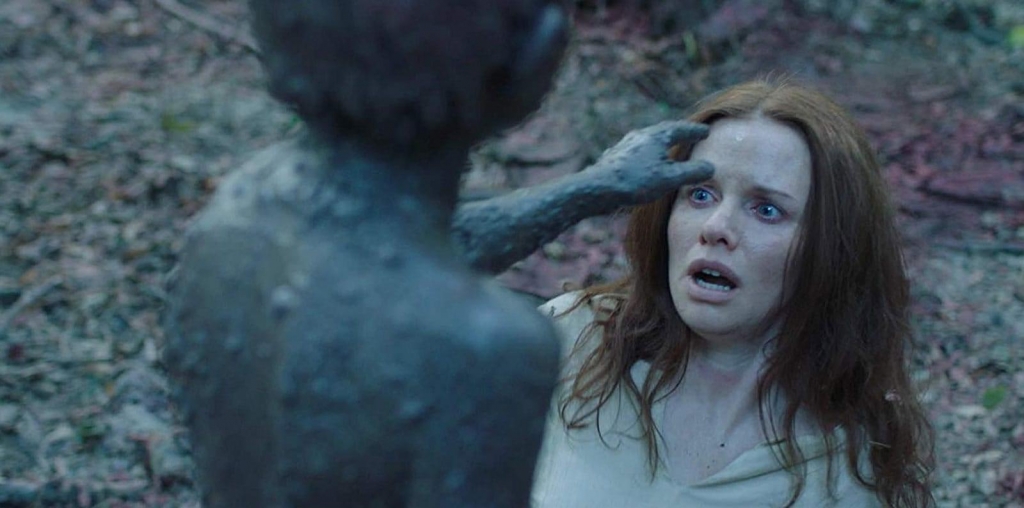
In The Golem, Hani Furstenberg plays Hanna, a woman living in a Lithuanian shtetl in the 1600s during an outbreak of The Black Death. A group of gentiles who live nearby suspect their Jewish neighbors of cursing them with the plague, and threaten to massacre the village unless the spell is lifted. Hanna fears for her people, yet her ability to intervene is limited by the norms dictating women’s behavior in her deeply traditional religious society.
With a stubborn determination that defines her character, Hanna defies the admonitions of the patriarchs and takes it upon herself to fight back. Having secretly studied Kabbalah from Jewish mystical texts, Hanna finds a way to summon a golem, which she believes is the only thing that can save her community. Once animated, the golem proves to be a powerful protective force. Though it remains linked to its creator’s will, it is not long before the villagers realize that the creature is unpredictable and difficult to control, as it begins to terrorize the people it was meant to defend.
Golem narratives often invoke ethical questions of an individual’s right to intervene for the greater good, even if others must suffer as a result.
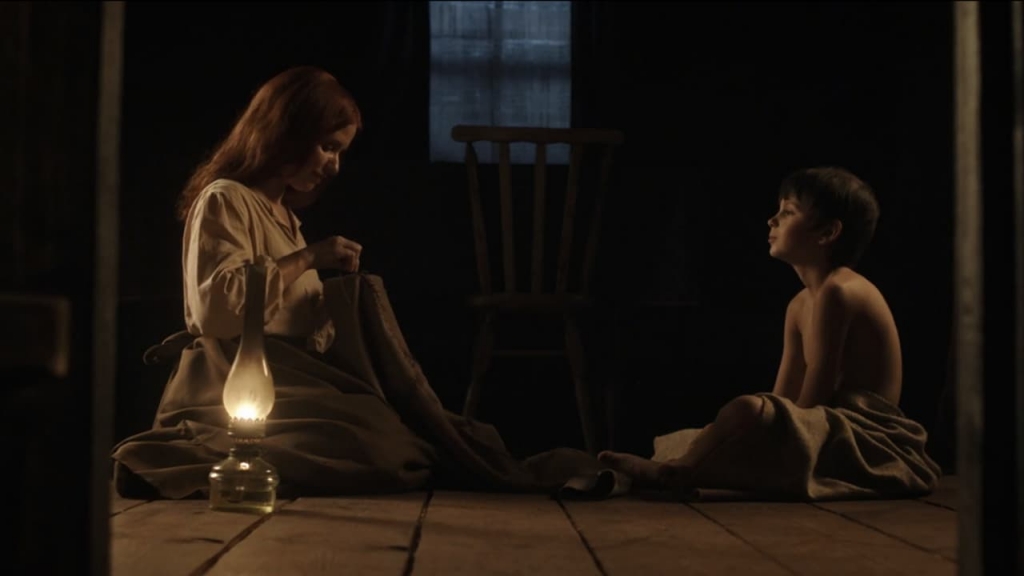
In many horror stories with religious themes, the use of magic or science to meddle in life and death is often represented as an act of defiance against God or submission to Satan. In Jewish lore, the golem and the forces used to create it are neither good nor evil, but simply reflect their human creator’s intentions. The golem reveals more about Hanna than it does about the power that gave it life, its deeds a manifestation of both Hanna’s destructive and protective inner desires.
While golems are usually simple anthropomorphized blocks of mud, this creature takes the form of a perfectly formed flesh-and-blood human boy.
The choice to depict the golem as a child, with a female creator, illustrates the film’s central focus on the question of who has the ability and the right to create life and to destroy it — a question that is compounded by Hanna’s complicated relationship with motherhood, fertility, and autonomy over her own body.
Judaism as a backdrop for supernatural religious horror offers an opportunity to focus away from predictable contrasts between good versus evil, or between God versus the devil. In many ways, Judaism is more preoccupied with the grey areas that reign in the human realm. Hanna’s world is dominated by strict rules about the choices a person is expected to make to stay in God’s graces.
But in the face of the vilest human impulse to destroy one another, intervention from God or the devil is nowhere to be seen. All that remains is personal choice.
THE WICKER MAN (1973)
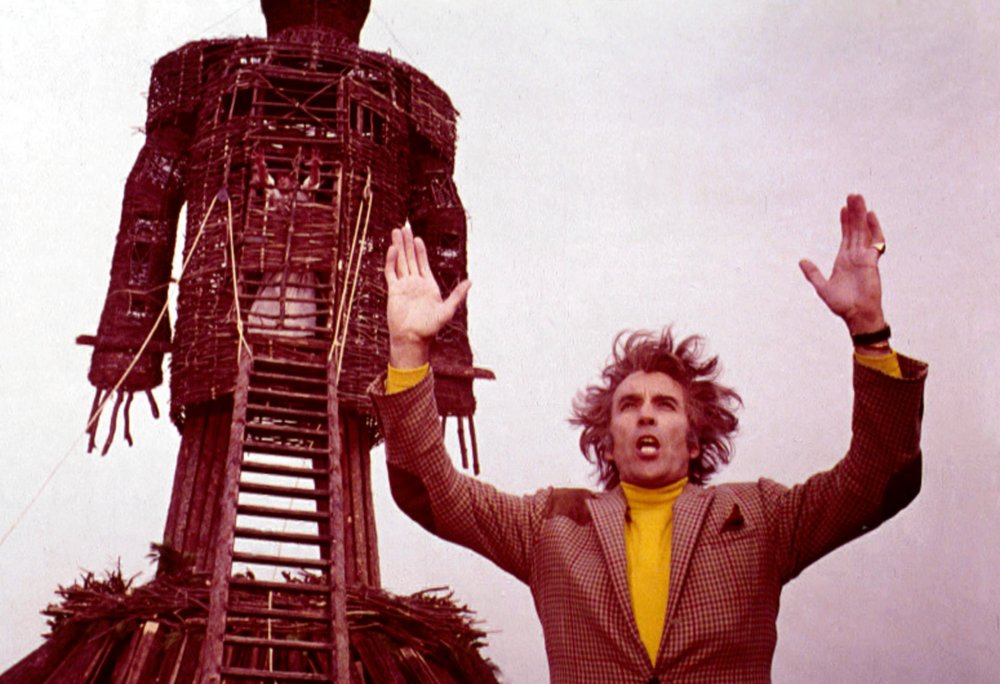
Recommended by Richard Rowntree
Often cited as one of the films belonging to the “Unholy Trinity” of the Folk Horror sub-genre (alongside Blood on Satan’s Claw and Witchfinder General), The Wicker Man is a fascinating exploration of religion in horror – primarily because of the juxtaposition of the religions represented within the film.
Whereas a lot of religious themes in horror focus on the traditional battle of “good” (see; religious) vs. “evil” (within the belief systems presented in the texts), The Wicker Man instead relies on the differentiation between the religions of the main characters. The fanaticism of belief is where the true horror lies.
The puritan protagonist of the film is Sergeant Howie (Edward Woodward) – a stern, unlikeable character who embodies the Christian faith at its most extreme. He doesn’t believe in sex before marriage, he holds other belief systems in disdain, and he generally considers himself better than anybody who doesn’t share his beliefs. In the course of his job as a policeman in rural Scotland, he is summoned to Summerisle – a small island, only reachable by sea plane. His mission: to investigate the mysterious disappearance of a young girl named Rowan.
On arrival, he is immediately immersed into what he views as a “primitive” culture with a pagan belief system, one which gently eases its claws into his psyche and, eventually, his physical being.
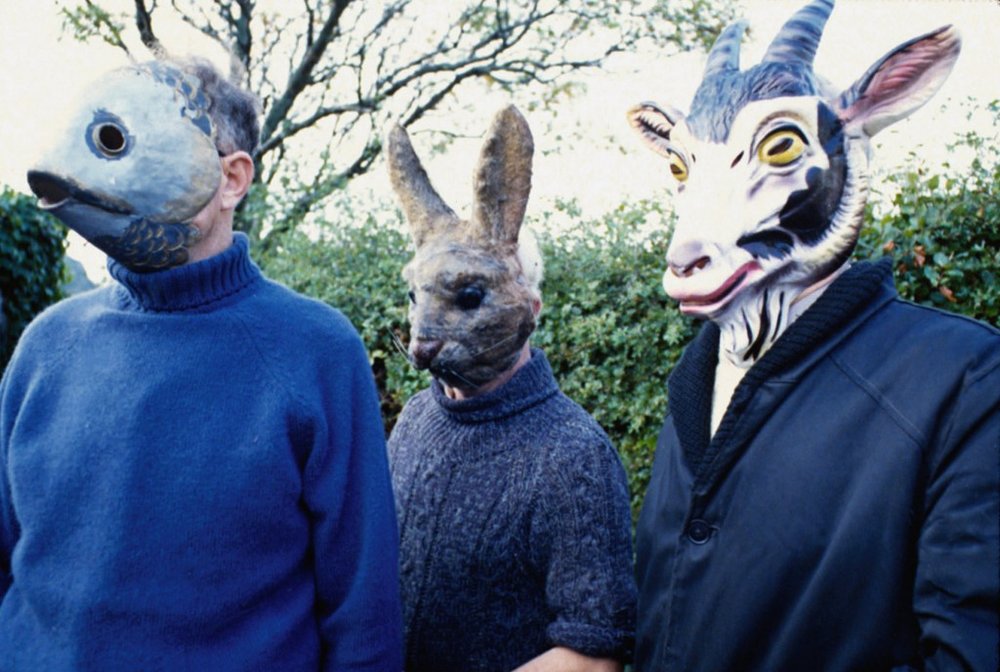
At the centre of the island is Lord Summerisle, played by Hammer staple Christopher Lee in a deliciously over-the-top performance. He holds court over his people while they engage in naked dancing around fires, amidst a Neolithic stone circle in the grounds of his grand home. They wait with bated breath on his plans for them. And generally, they all seem far more concerned with the success of the forthcoming harvest than the whereabouts of the poor missing child.
When Howie eventually discovers the whereabouts of Rowan, she leads him to discover the real reason why he came to the island – to become a ritualistic sacrifice to the Pagan Gods of the islanders. And it is because of his puritanical beliefs that he must be sacrificed to the giant Wicker Man sculpture. His own God has forsaken him, and despite knowing this, he still holds strong with his beliefs.
In a brilliant twist, the protagonist is never likable. Rather, his dogged faith actually allows the audience to side with the antagonists of the film. As an exercise in contrasting belief systems, The Wicker Man stands alone.
…
SECOND 6
END OF DAYS, HELLRAISER, PRINCE OF DARKNESS, RED STATE, CARRIE, MARTYRS
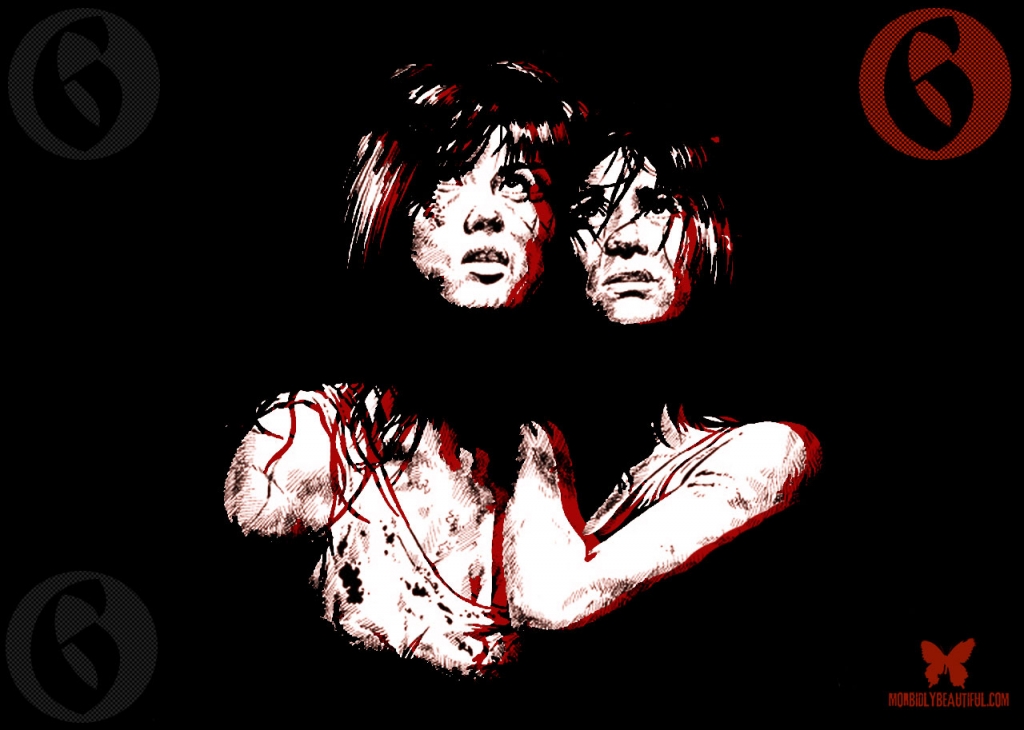
“Can you imagine what happens to us after death? Be doubtful.” – Martyrs
END OF DAYS (1999)
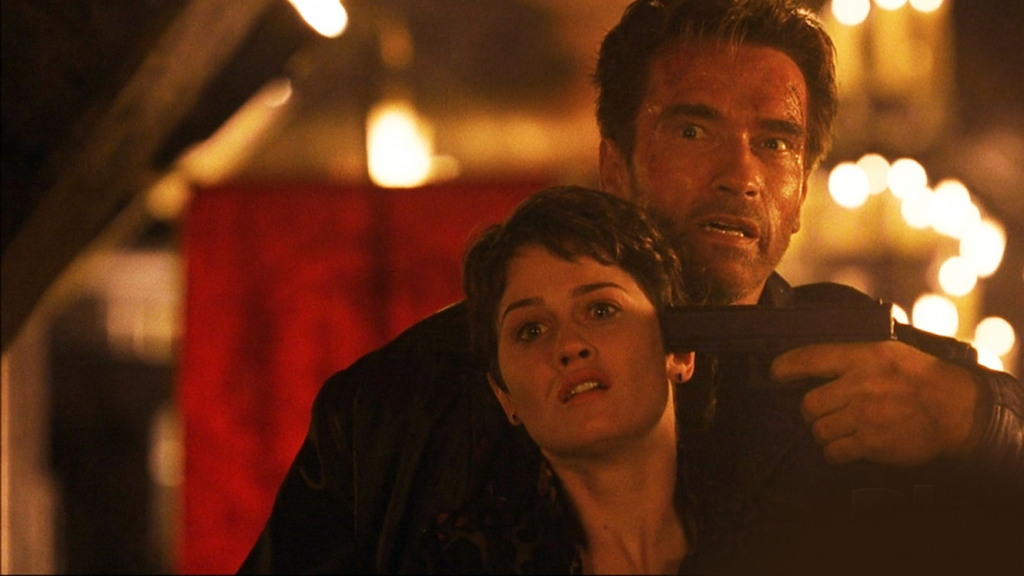
Recommended by Jason McFiggins
The end of days may not have happened, but the end of all breakfast smoothies did: mix coffee, Pepto-Bismol, what’s left in the glass from last night’s beer, a little leftover Chinese, and dash of pizza found on the floor — and voila! Breakfast is served. It’s the kind of over-the-top goofiness we’ve come to expect from hard drinking, faithless, tough guy, anti-hero movie cops. And Arnold Schwarzenegger’s Jericho Cane in End of Days is no different.
In this big budget, Hollywood action/thriller, the copy-and-paste formula runs rampant (including the wise cracking sidekick, played by Kevin Pollak). But Arnold is always game for these bombastic, devil-may-care type of roles. Besides, it takes a devil to catch the devil. And between the two, my money’s on Arnold.
But the end times will require more than just a come-get-some attitude and big ass guns — being held up by muscles the size of human heads — in order for Arnold to save the day.
He’ll have to exercise a different kind of muscle, one he has long ignored: faith.
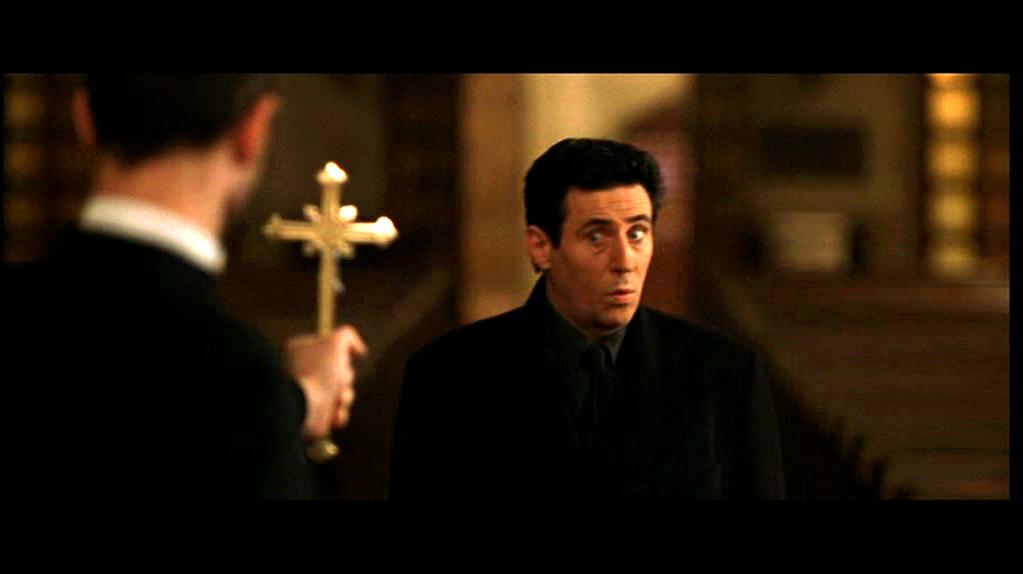
Looks like the big guy needs a little help from The Big Guy, even though he chooses not to believe in Him after his wife and young daughter were tragically killed. His chance to make amends with the Man upstairs comes in the form of Christine York (Robin Tunney), a young woman destined to carry the child of Satan (Gabriel Byrne, a slimy, smooth talking, scene stealer).
This is where the redemption story begins; a journey of spiritual awakening. When Jericho stands in a church towards the end of the film and tosses his gun aside, praying through tears, “Please, God, help me, give me strength,” damn does Arnold deliver — it’s the most sincere moment in the film — followed by a wicked creature design for the big showdown between good and evil.
Tack a religious angle onto Terminator 2 and you pretty much have End of Days.
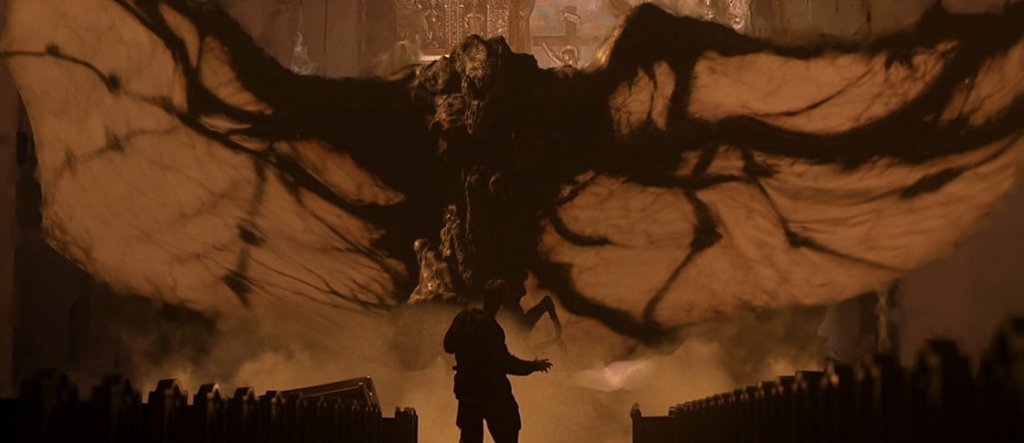
It’s big, silly and heavy-handed (Jericho Cane = JC), but End of Days makes for an entertaining two hours. There are lots of gunshots, a good amount of blood and gore, classic Arnold dialogue, dark, cop-filled streets, fiery action, and musty churches.
And as far as Hollywood blockbusters go, that’s all Gospel according to the Book of Arnold.
HELLRAISER (1987)/HELLRAISER 2 (1988)
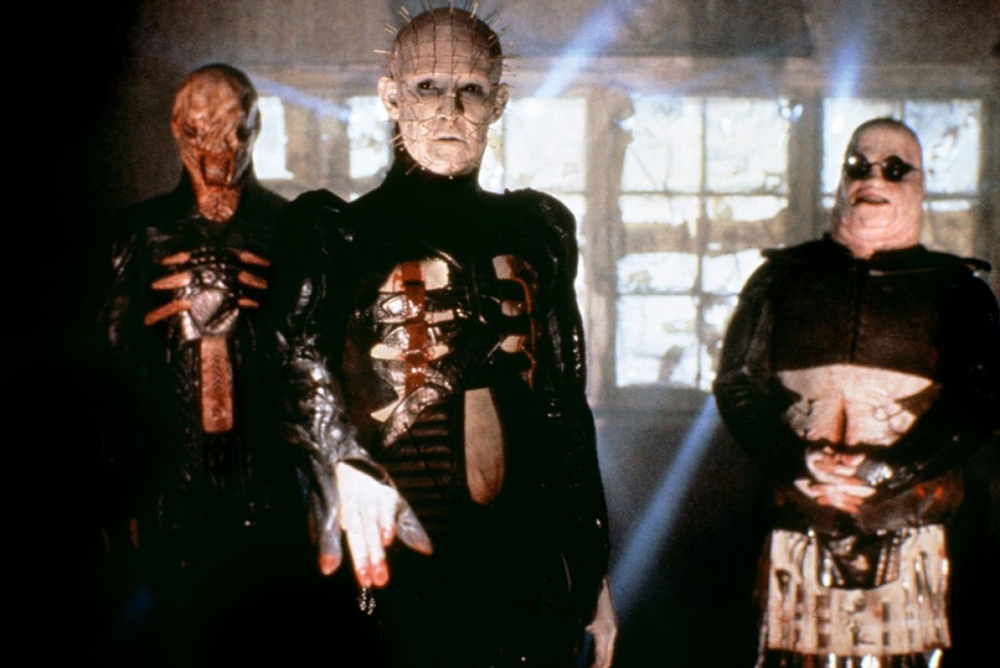
Recommended by Kourtnea Hogan
Judeo-Christian imagery and its ideals are inseparable from the imagery and themes of Hellraiser. Although they are often juxtaposed, these themes are most evident when it comes to the film’s central, supernatural antagonists, The Cenobites — the very word meaning “a member of a monastic community”.
The Cenobites in Hellraiser may not be what most of us would picture demons to look like; and they certainly are not our traditional idea of angels, no matter what Pinhead might want you to believe. Their BDSM garb is an abomination of the traditional cassock — the long dress you’ve seen at the pulpit of every Catholic mass — here permanently fixated to the wearer, fastened with chains, pins, and hooks. They are designed to inflict pain and suffering; an integral part of the Christian religion.
The biggest separation, however, between Clive Barker’s Hell, and the lake of fire we’re all familiar with, is that Barker’s realm is more forgiving.
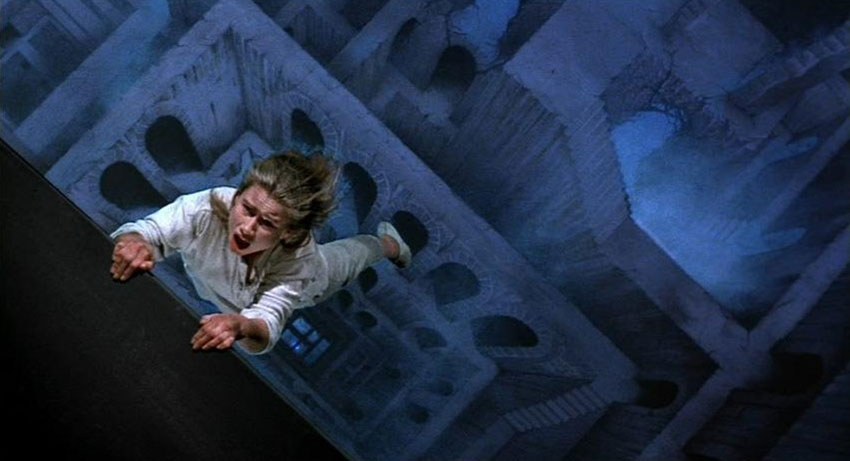
In Hellbound: Hellraiser 2, we meet a young girl named Tiffany (Imogen Boorman), a mute patient in a mental hospital with a penchant for solving puzzles. Tiffany is an innocent, and her mystic-obsessed Dr. Channard (Kenneth Cranham) uses her skills to solve The Lament Configuration, the metal cube used to unlock the gates of Hell.
She solves the puzzle and the Cenobites are summoned, surrounding her, sharpening their blades in anticipation. But they are stopped by Pinhead.
“No. It is not hands that summon us. It is desire.”
Compared to the Catholic belief that you are cursed to eternal damnation if you don’t believe in Jesus, no matter how many good the deeds or how good your heart was, this seems quite a bit more lenient.
Judeo-Christian religion is rooted in the idea of receiving pleasure (closeness to God) from pain (sacrifice and suffering).
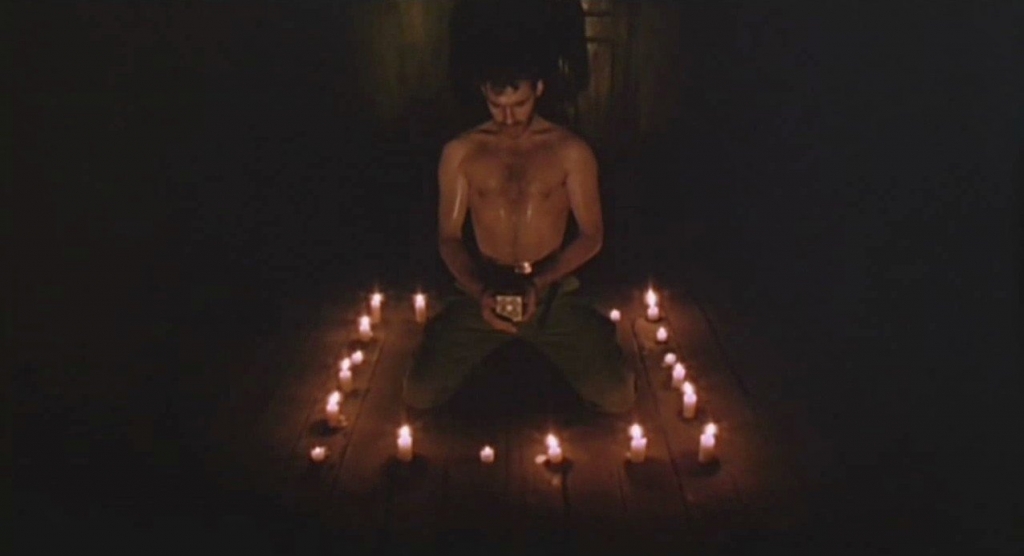
While many religions equate the denial of pleasure (pain) — the avoidance of “sin” — with spiritual reward, some take it much further than that.
The practice of self-flagellation — causing pain to oneself to atone for sins — was utilized by some Christians throughout most of Christian history, especially in Catholic monasteries and convents. It’s in this act of physical pain and the subsequent ‘forgiveness’ derived from it that one finds peace-of-mind or, in some instances, divine pleasure.
The idea that people draw pleasure, especially sexual pleasure, from being physically harmed is one that mainstream media tends to shy away from.
However, it is an idea thoroughly embraced in Hellraiser.
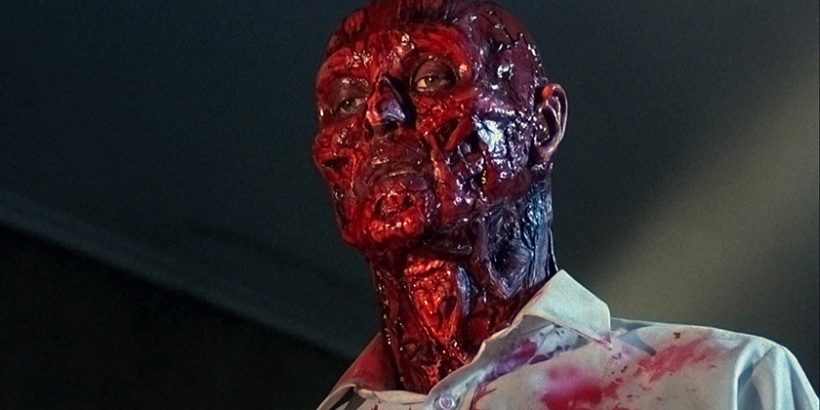
The horror violence that permeates Hellraiser is fine and dandy to the censors and to the general public, but the slight insinuation of fetishes involving pain, blood, and leather is clearly a step too far.
Even Hellraiser does a bad job of representing the BDSM community, creating a deviant sexual monster in Frank. And though the cenobites come from the monastery of torture, it is the promise of indescribable pleasure that compels Frank to explore the darkness of cenobites realm.
This blurring of the lines between Heaven and Hell, sin from salvation, is what makes Hellraiser such a compelling and enduring vivisection of religious faith.
PRINCE OF DARKNESS (1987)
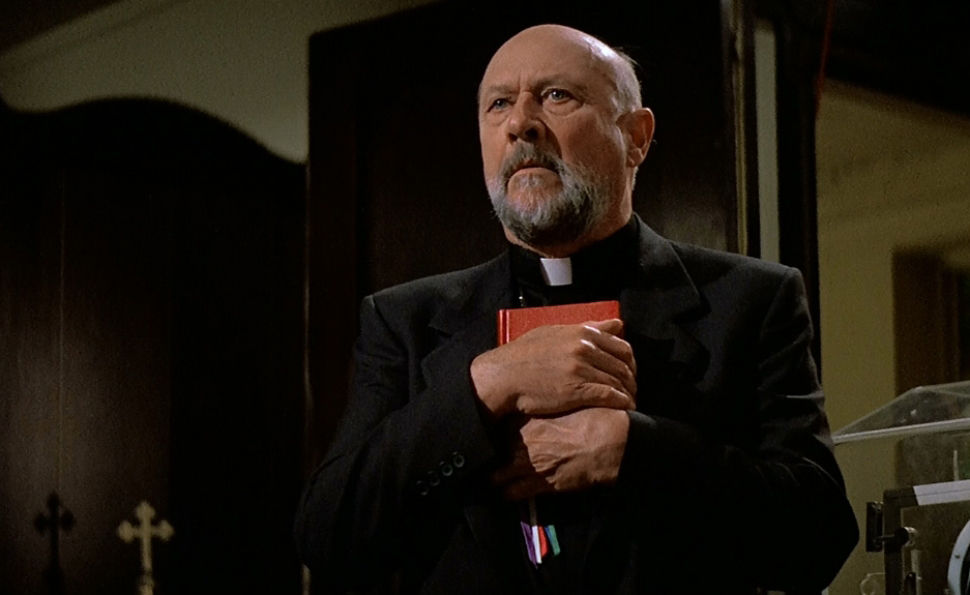
Recommended by Jerry Smith
While Halloween, The Thing, and Escape From New York tend to be the films most commonly mentioned when talking about John Carpenter, as far as this writer is concerned, his scariest film (not his best, that will always be Halloween for me) is 1987’s Prince of Darkness.
Filled with religion-based horror and some of Carpenter’s most memorable moments, Prince of Darkness follows a priest (played by Dr. Loomis himself, Donald Pleasence) who discovers that Satan is alive in the form of a green liquid being stored in an old church. The priest enlists the help of a quantum physics professor and his students to help study the liquid and try to decipher the evil. But in true Carpenter fashion, the evil begins to kill and take each of them over, one by one.
Let’s be honest here, this film is a lot.
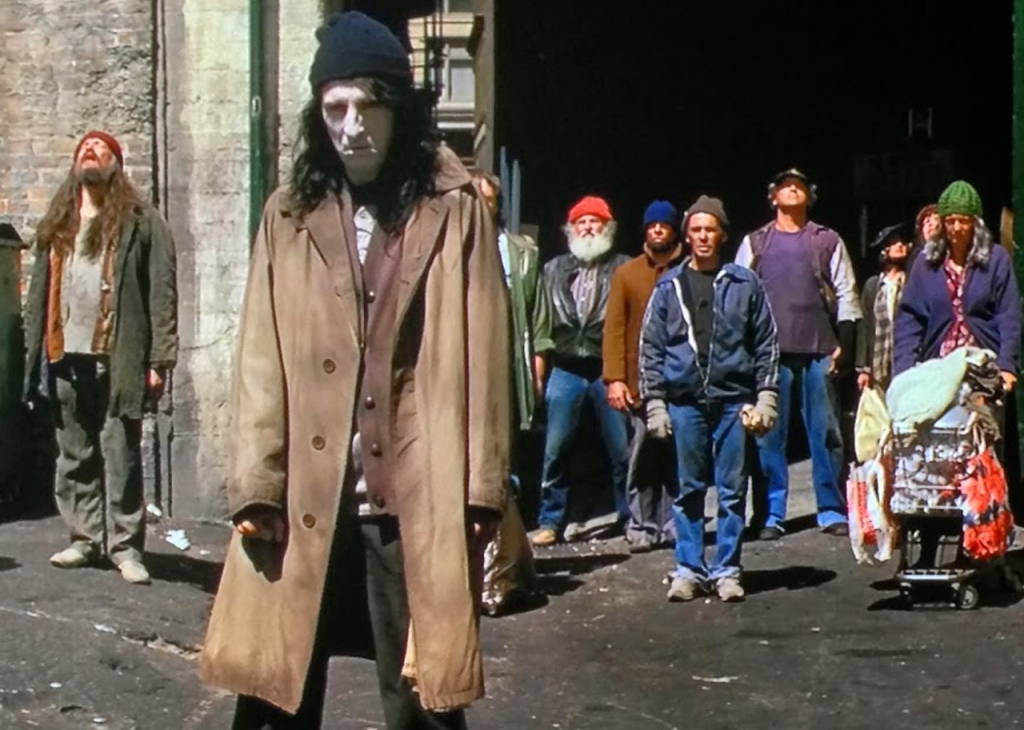
Carpenter’s interest in quantum physics is front and center in Prince of Darkness. And being such a heavy film, filled with ideas and themes that were more complex than what 1987 cinema was usually offering, resulted in this gem being ill-received upon release.
I personally adore this scary as hell, thought-provoking film. We typically get a charismatic portrayal every time we’re given a “Satan” to follow in horror — memorable performances include: Al Pacino (The Devil’s Advocate) and Viggo Mortensen (The Prophecy) — but the fact that Carpenter could make a film that gives us Satan in the form of green liquid is simultaneously insane and brilliant.
The addition of Alice Cooper as an evil vagrant leading a group of undead-like beings, the film bypasses humor for horror. The tone is heavy and dark, and it could very well be Carpenter’s most cynical film. But that’s what makes it work so well.
Frightening imagery, an exceptional score (courtesy of Carpenter and Alan Howarth) and Carpenter regulars such as Pleasence, Victor Wong, Peter Jason and Dennis Dun all help to make Prince of Darkness a really entertaining and downright terrifying entry into the religious horror sub genre.
RED STATE (2011)
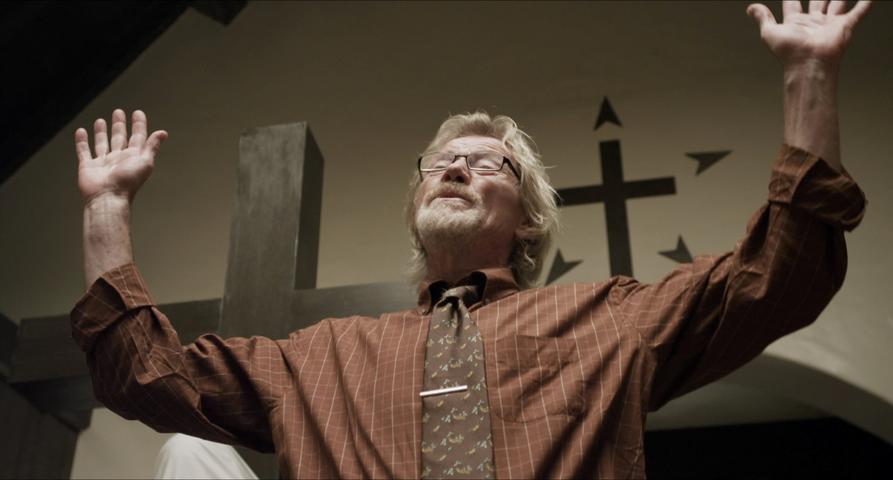
Recommended by Jamie Marino
Red State has been called both a horror movie and an action movie. It isn’t either one of those things. It’s too deadpan to be a horror movie, and too serious to be an action movie. After hearing his stand-up comedy and seeing Dogma, the idea of Smith attacking both the Westboro Baptist Church and the hair-triggered Bureau of Alcohol, Tobacco, and Firearms in one movie made this a must watch for me.
In Red State, three teenage boys find an opportunity to inexpensively bust a nut, but they get more than they bargained for when the generous lady drugs their beer. They wake up as prisoners of a Westboro-esque Baptist Church. This is when Kevin Smith shines as a writer, and Michael Parks digs under the skin as an actor. Parks plays Abin Cooper, the leader and preacher of the Five Points Trinity Church. The mass he is presiding over is going to be concluded with the execution of at least one gay man.
The priceless jewel in this movie is an extended centerpiece, a sermon by Cooper (Parks).
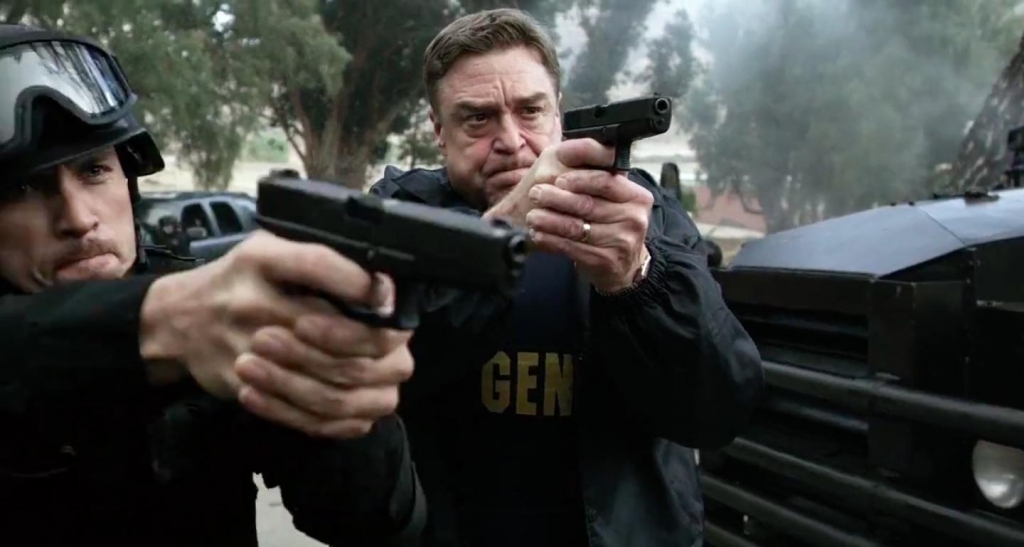
It is, without exaggeration, one of the most horrifying things I’ve ever seen in a movie. I won’t quote it, because I want you to experience it for yourselves. If, for some reason, you choose to pass on Red State, the sermon scene can be accessed on YouTube. It is essential that you experience it. Parks is incredible.
At this point in the movie, a team of ATF officers descend on the compound. The man leading the operation, Joseph Keenan (John Goodman), asks for a peaceful surrender through a megaphone (how can anything shouted through a megaphone possibly be taken as peaceful and non-threatening?). There is no peaceful surrender, however. That’s when it starts raining bullets and blood. There is some phenomenal gun gore, and it all ends darkly and hilariously.
The Church and The State are both cold, bloodthirsty, and eager to crush anyone who disagrees with them. Funny, there’s all this fuss about separating Church and State, yet they go so well together.
CARRIE (1976)

Recommended by Vicki Woods
Carrie is the first Stephen King novel I ever read. I was enthralled with the story and hung on every word. Brian DePalma’s film adaptation is, to this day, one of my favorite horror films and one that has affected me deeply. Religious fanaticism is at the center of this disturbing coming-of-age horror.
Margaret White, Carrie’s mother, is a religious zealot, who emotionally and physically hurts her daughter in the name of her beliefs. I’m not saying that all super religious people think the way Margaret does, but there are some crazy folks out there.
If we were to see a back story, I am sure Margaret was abused and was raised to believe what she eventually preached.
Margaret’s religion condemns everything that is normal about our bodies.
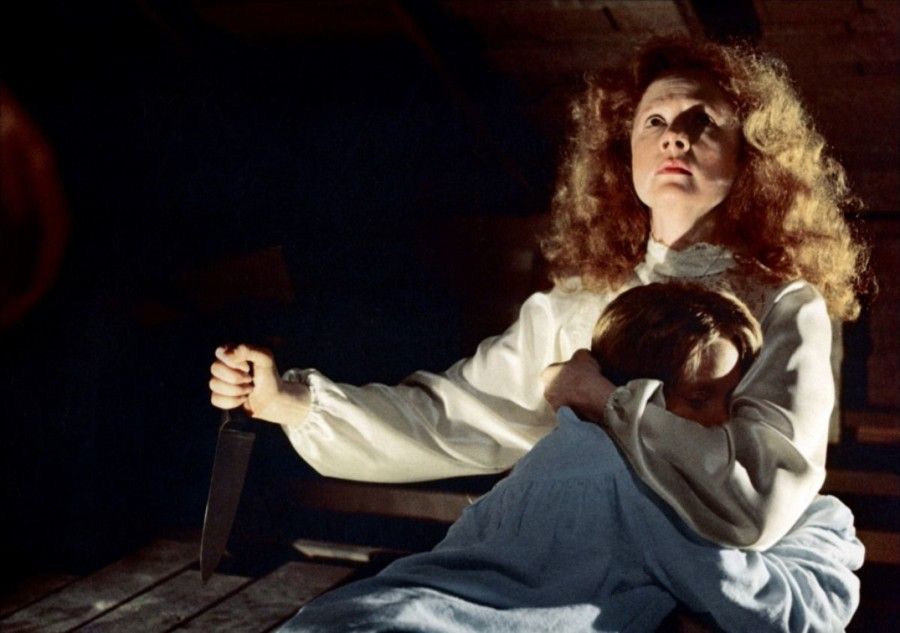
We are evil, sexually perverse creatures who should be locked in a closet to pray and if necessary, to be destroyed to save us from ourselves. When Margaret had Carrie, she believed the baby was a cancer — a punishment given to her by God for being for being weak and giving in to lust.
She continues to instill this belief in Carrie. But when Carrie discovers her telekinetic powers, the anger from this controlling and abusive upbringing, and the bullying she has endured in school, spills over into vengeance.
There are two feature film versions of the book, very similar, but different in that we see more of the relationship between Carrie and Margaret in the 2013 version than in the 1976 one. Both are well done, though I truly love the 1976 Brain DePalma version best.
The central theme of the films is blood.
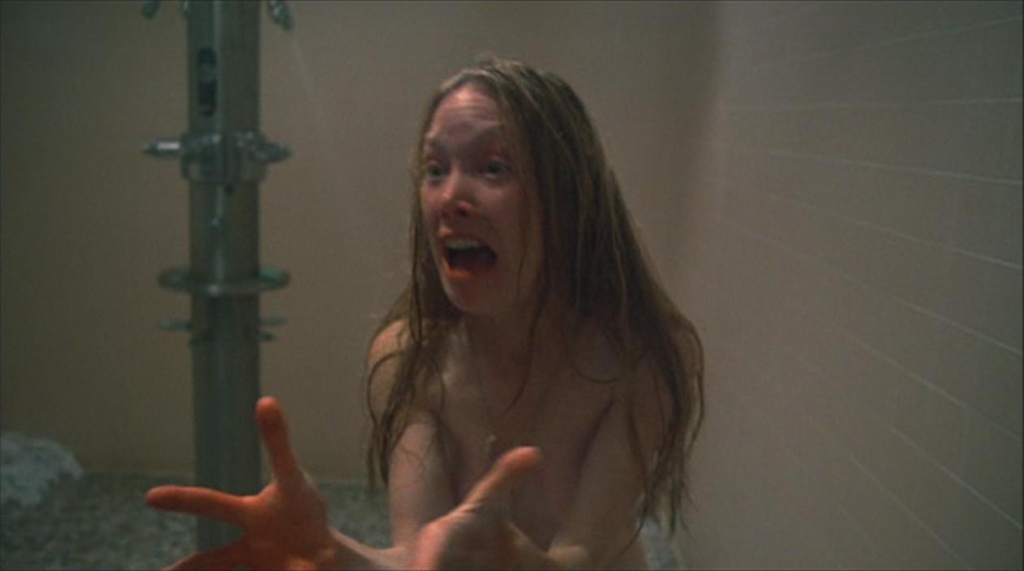
The famous scene of Carrie starting her period and being laughed at by bullies is intense. And in the finale, blood is the focal point. It is both heartbreaking and exhilarating when Carrie takes control.
Religion can be dangerous in the wrong hands. CARRIE is a terrific example of this. What could have been a comfort to a girl having a rough time through puberty becomes the catalyst for her personal shame, repressed anger and eventual self-destruction.
MARTYRS (2008)
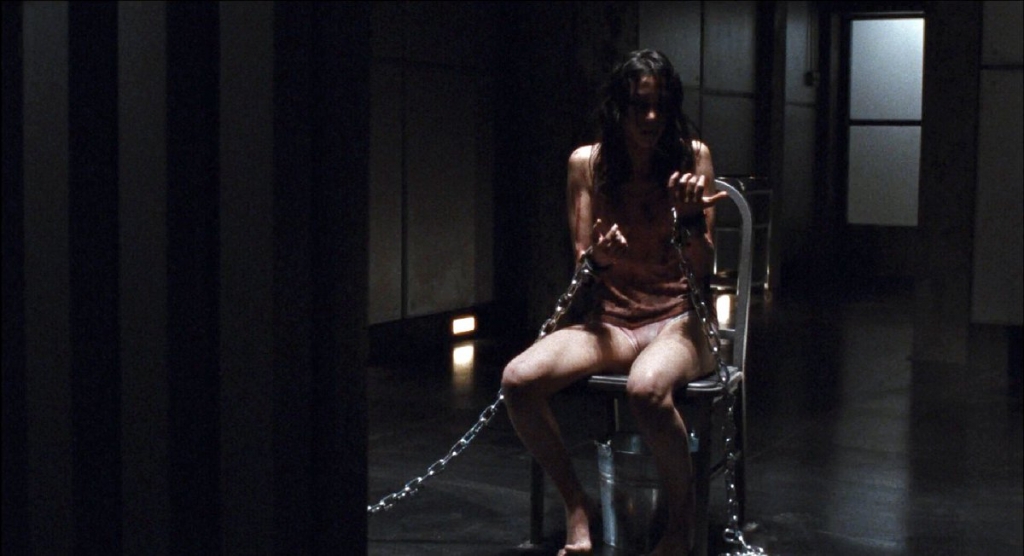
Recommended by Danni Winn
“The idea of a horror film failing to make a lasting effect, leaving you exactly the same as when you went into it, is really sad to me.” – Pascal Laugier
In 2008, Pascal Laugier polarized audiences with his unforgettable addition to the genre, Martyrs. Rejected by all major studios in France due to its nature and content, Martyrs, thankfully, saw the light of day (thanks to legendary distributor Canal+ who also helped back David Lynch’s Mulholland Drive). It went on to traumatize, disgust and become one of the most celebrated contemporary horror films.
Martyrs doesn’t bash you over the head with religious beliefs. Instead, it sneaks inside your psyche, moving at a methodical pace while strategically demanding your attention and — as the film progresses — your fortitude. There are pointblank shotgun casualties, throats slit, self mutilation, and excruciating acts of torture.
But there’s also a heavy focus on man’s innate and undying need to know what, if anything, lies beyond.
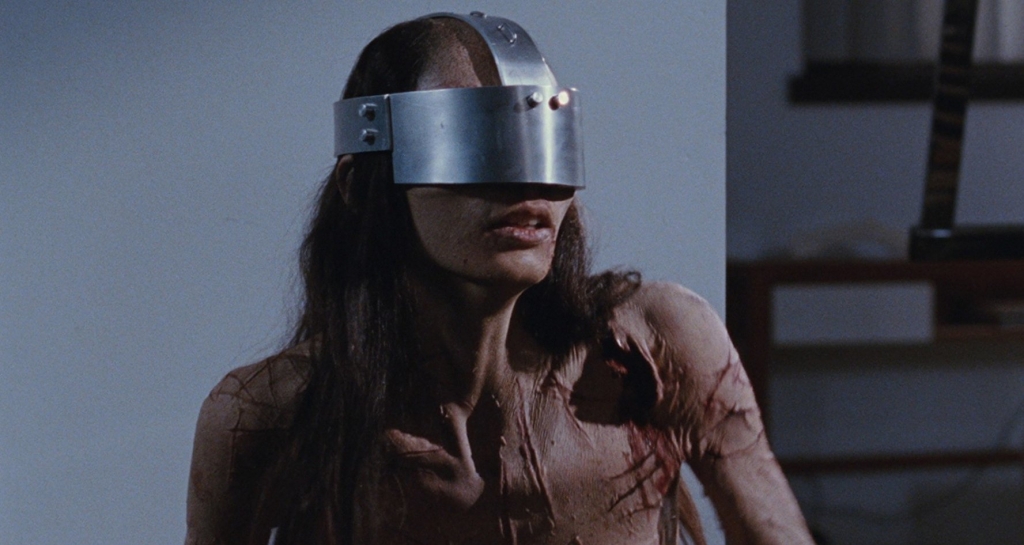
In the film, a secret philosophical society is trying to demonstrate that the significant absence of faith does not negate one’s ability to transcend; that the idea of a martyr as solely an invention of the religious world is sorely mistaken.
This is something so significant to me, that when I first viewed Martyrs, I wept.
Pascal’s skillful direction, the arresting cinematography, and the absolutely incredible performances from lead actresses Mylene Jampanoi and Morjana Alaoui are sure to assault some belief systems and rattle nerves.
Martyrs is provocative and nowhere near an easy watch, and this film deserves a disclaimer before viewing.
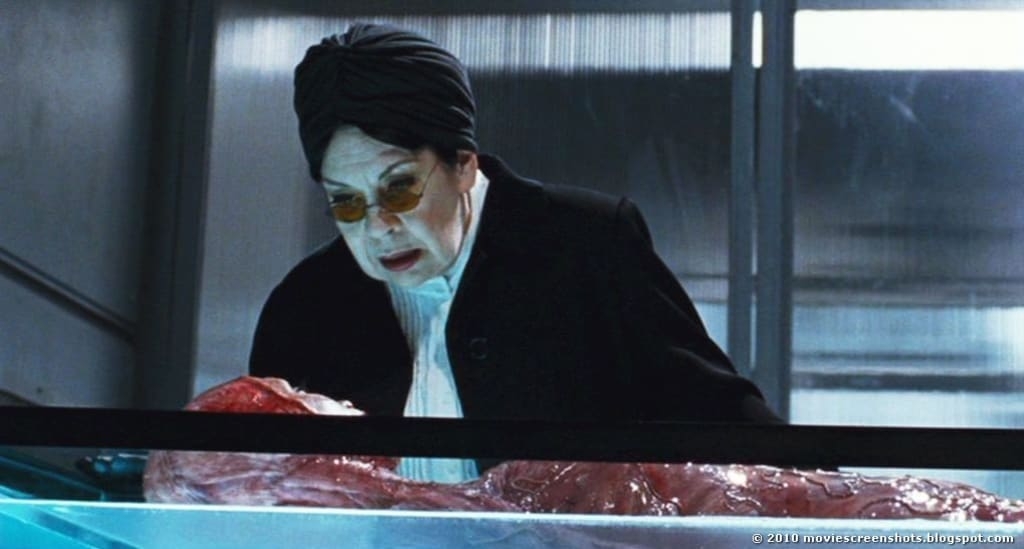
There should be a warning that what you’re about to see may be extremely disturbing — but it may also be profoundly affecting. The excessive gore does not bother me; I actually appreciate it. But what does leave a lasting impression is the beating heart that’s at the very core of the film, which often gets overlooked because of the bloodshed.
This flick is violent, vicious and graphic. But it’s also deeply moving and thought provoking. And once Martyrs is experienced, it is rarely forgotten.
…
THIRD 6
MOTHER!, THE WAILING, THE AMITYVILLE HORROR, THE RITE, THE BLACKCOAT’S DAUGHTER, THE DEVIL’S DOORWAY
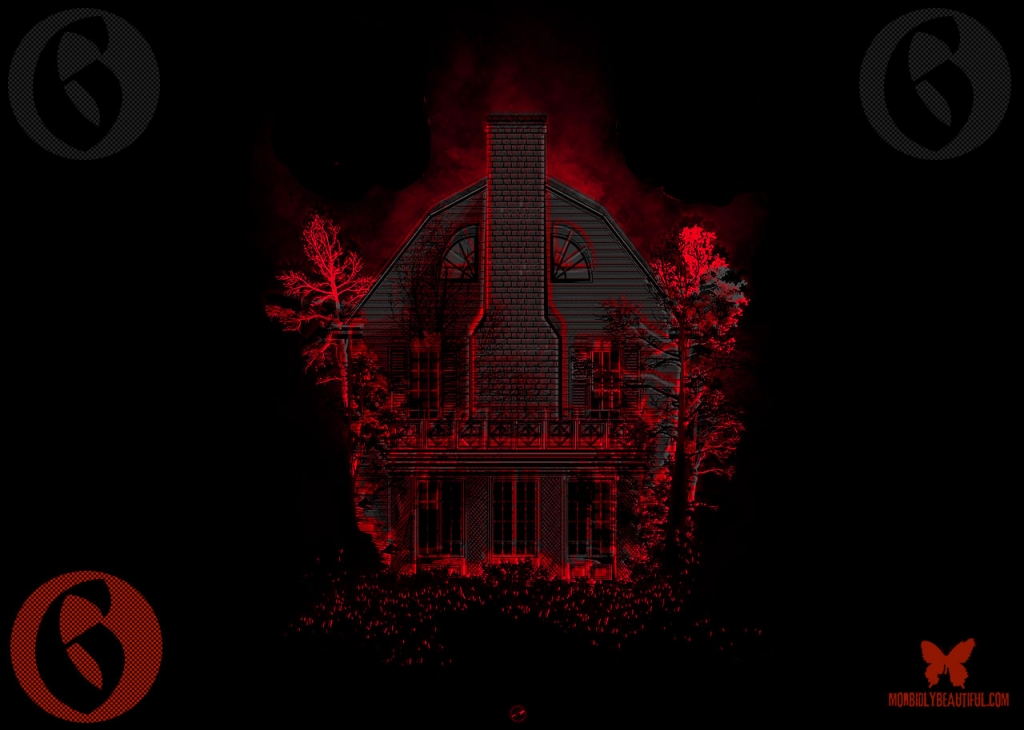
“My point is I believe we create our own demons in our minds.” – The Amityville Horror
MOTHER! (2017)
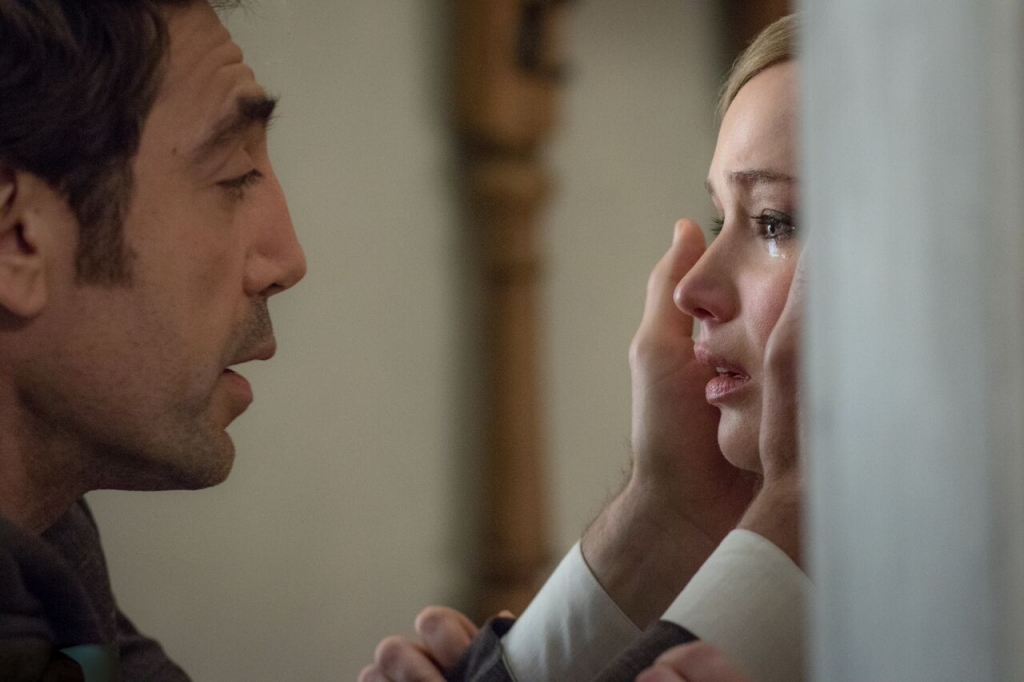
Recommended by Jamie Marino
I’m not sure how high Jennifer Lawrence is on the “in-demand actress” list right now, but if she dropped from the top 5, Mother! may be the reason why.
Mother! is a Biblical Genesis allegory. Javier Bardem is a character simply named “Him”, and Lawrence is a Mother Nature/Birth/Rebirth representation named “she”. “She” is also pregnant, which makes me wonder if mankind is who/what she is carrying, and the house is her perfect, living, beautiful Earth.
Leaving Him’s name capitalized is not a mistake, either. “He” is God and “she” is mother nature, building her ideal home (Earth). When “man” (Ed Harris) and “woman” (Michelle Pfeifer) drop by unannounced, believing it to be a bed-and-breakfast, all of the progress “she” has made thus far on her home slowly unravels.
“Man” and “woman” represent Adam and Eve, and there are several elements of the Adam and Eve story that are either told in a revisionist way, or outright disjointedly.
This is, in fact, the point in the movie when the lines between Scripture, truth, and reality are slapped together with hot glue, then melted into toxic Jello with blood clots for Cool Whip.
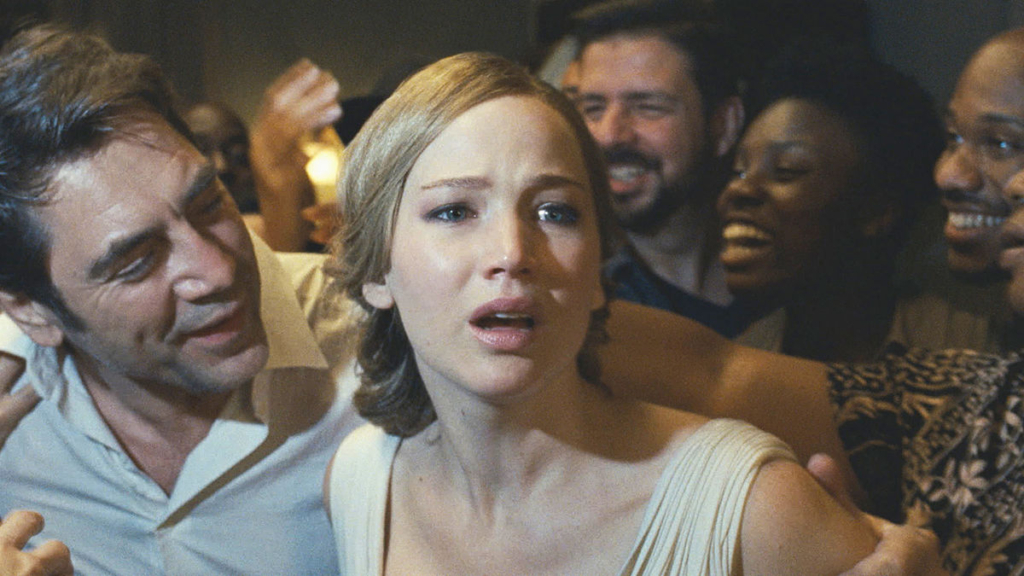
Him is a poet suffering from writer’s block, but his creative juices begin flowing again when “man” and “woman” declare how much they love his work. I believe this is all meant to spin our minds and beliefs on a cerebral playground roundabout. Director Darren Aronofsky is not necessarily saying this did or didn’t happen (don’t have a movie make that decision for you), but is instead presenting us with an interpretive, alternate timeline.
I don’t think MOTHER! is anti-faith or anti-god. I think it abstractly (and loudly) presents us with the dangers of fanatical religion, and the possibility that God was killed by his own overzealous and greedy followers.
THE WAILING (2016)
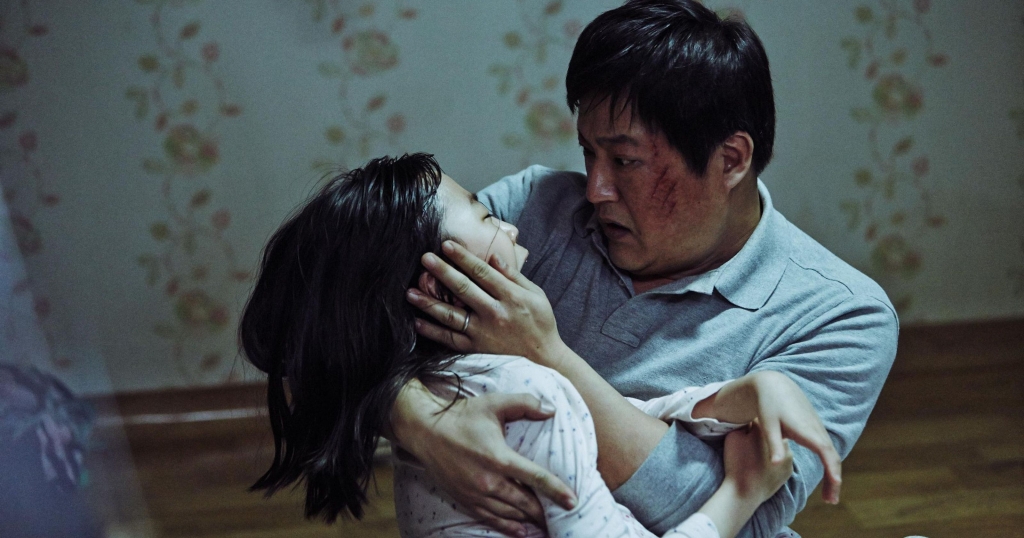
Recommended by Lizzy VB
Korean movies have always been favorites of mine, and I’m thrilled to see that they are increasingly gaining footing in the mainstream — thanks in large part to Parasite’s history-making Academy Award for Best Picture. Korean films have proven to be generous with both entertainment value and meaningful social commentary.
Na Hong-jin’s two-and-a-half-hour opus, The Wailing (2016), is in many ways a deeply philosophical exploration of faith, presented under the guise of a murder mystery. What makes it so powerful is that it asks the same of its viewers as it does of its protagonists: to decide what to believe based on trust alone. It is hard to give the film’s depth its due without revealing crucial plot points, so read ahead with caution if you’d rather avoid spoilers.
A police officer, Jong-goo, is tasked with solving the mystery of why a strange illness that has befallen the town — one that seems to induce a murderous mania that causes people to turn on their loved ones.
The film touches on themes of xenophobia and superstition.
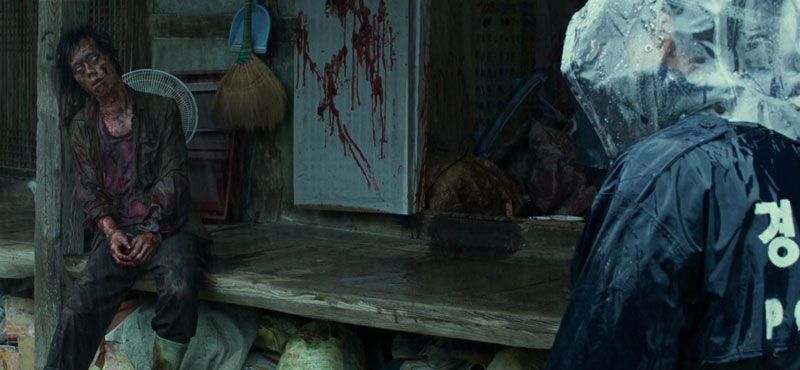
A Japanese hermit is the first suspected culprit in a plague that seems more like the work of a malicious entity than a natural pathogen.
Meanwhile, a nameless woman surfaces, appearing seemingly at random to taunt Jong-goo with cryptic adages. As the film progresses, it becomes clear that one of these unusual strangers is responsible for the mayhem in the village, while the other may hold the key to the antidote. When Jong-goo’s daughter becomes afflicted with the disease, his ability to discern between the two becomes a matter of extreme urgency. The wrong choice could mean forsaking his family and his village to a truly malevolent force.
The choice is agonizing, even for the viewer.
Just when you begin to trust yourself to distinguish good from evil, you are whiplashed into realizing that evil is skilled in deception and that righteousness sometimes manifests in convoluted ways. The big reveal comes five minutes before the credits roll and smacks you in the face like a ton of bricks.
It is in that moment that you realize that, more than anything else, the film demands faith.
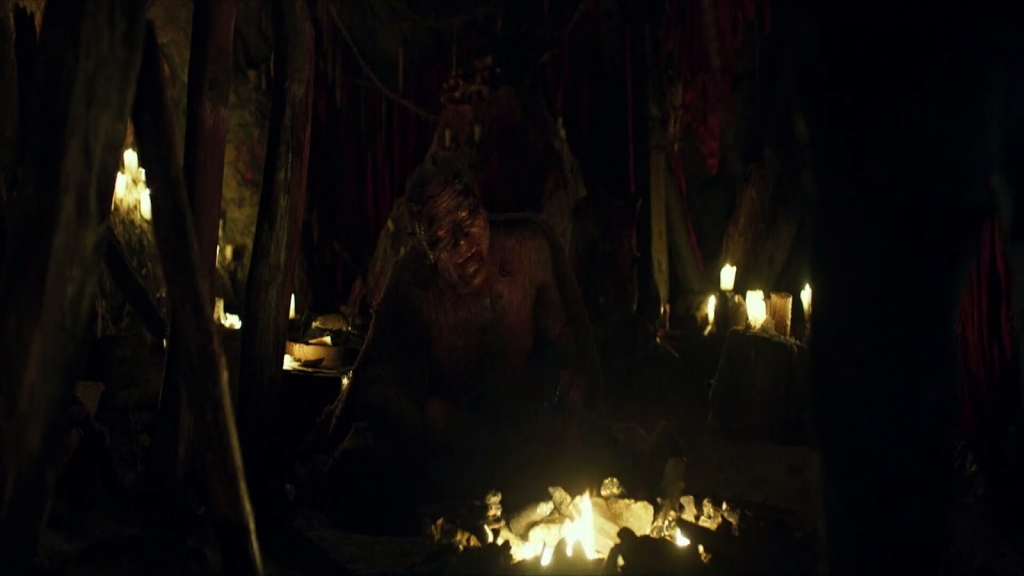
Faith is the willingness to trust in the absence of proof or certainty — the valuing of belief over evidence. Not coincidentally, faith is one of the most essential foundations of Christianity. The Wailing has a Christly figure of its own who, like in the Biblical stories, is shunned by those who refuse to believe.
If the religious undertones aren’t already evident, the film invokes Korean folk practices as yet another potential direction — in the end, a mere distraction from the true path.
As emotionally exhausting as it may be, the two-and-a-half-hour investment is well worth it. In my opinion, no movie more artfully explores Christianity’s most essential foundations, and so gut-wrenchingly illustrates what holding onto faith requires of a person.
THE AMITYVILLE HORROR (1979)
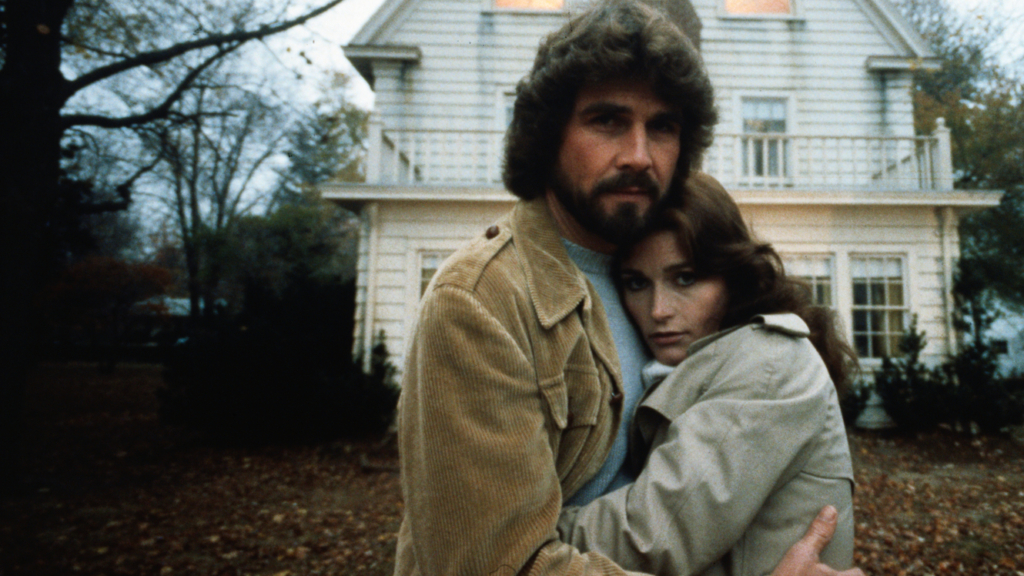
Recommended by Jessica Nicole (Spinsters of Horror)
The Amityville Horror, directed by Stuart Rosenberg and starring James Brolin and Margot Kidder, is based on the supernatural horror novel by Jay Anson. It is based on the supposedly true paranormal experiences of the Lutz family after they moved into the same home where the mass murder of the DeFeo family was committed by Ronald DeFeo Jr. a year prior.
Both the novel and film chronicled the Lutz family experiences and paranormal occurrences as they attempted to settle into their new home, with the focus being on the family’s patriarch, George Lutz, as he slowly became possessed, almost driven to commit the same atrocities that occurred in the home last year. As mentioned, this is supposedly based on true events. But due to the lack of evidence and inconsistencies in the stories, it is considered to be a hoax. Yet, the home still remains the most popular (rumored) haunted house in American folklore.
With paranormal experiences, it always seems like a religious element is involved.
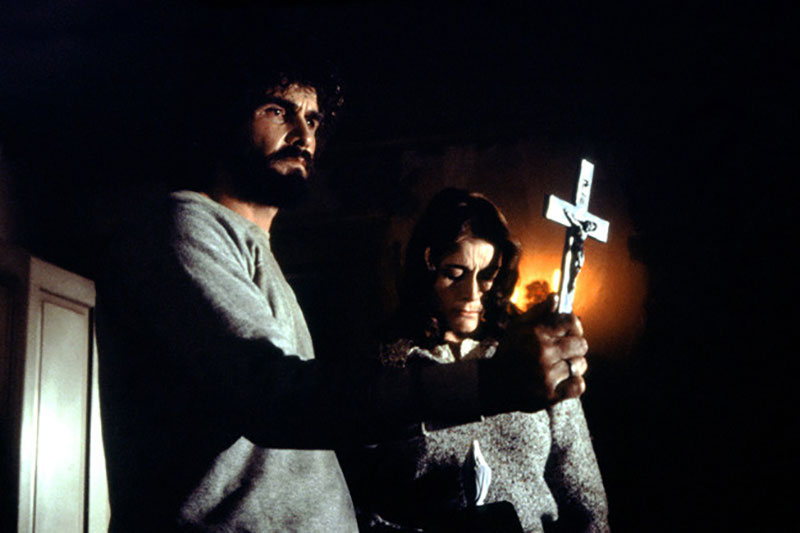
We were introduced to this religious theme of God vs. the Devil in The Exorcist (1973). Since then, we have seen many films in the paranormal sub genre portray this eternal power struggle. The Amityville Horror is no different.
Religious symbols are seen throughout the whole movie. Kathy was once a single mother who turned to religion and her parish priest Father Delany to help her through troubling times. She even asked the priest to come by and bless the new home with her new husband and children. Kathy has a close relationship with her Aunt Helena, who is a Catholic nun. She prays when she feels threatened by a presence in her home and when her daughter Amy is caught singing a popular Sunday School song, “Jesus loves me”, to her imaginary friend Jody.
These references to religion are supposed to give the viewer a sense of peace, because you feel like such a religious family should have divine protection.
However, each time a religious figure steps into the home or tries to help the Lutz family, they are met with tragedy.
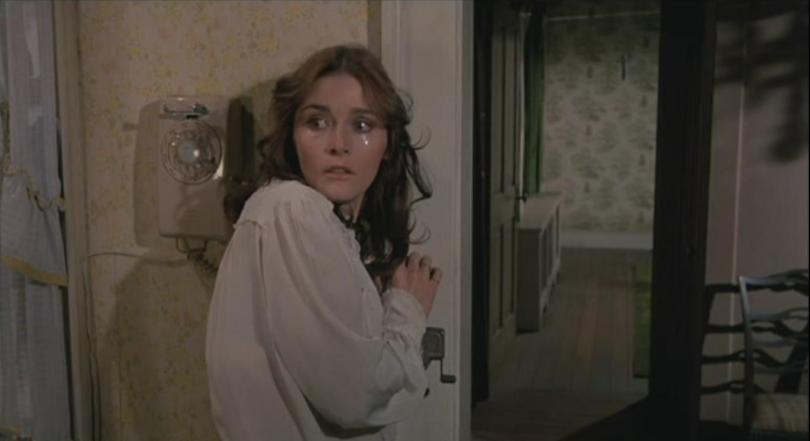
Aunt Helena is driven instantly from the house when she becomes violently ill, just as Father Delany was when he went to bless it. Each time he tries to help the Lutz family, warning them about the evil, he falls ill and eventually becomes blind.
The Lutz family is left to their own devices. They cannot rely on the church they have put their faith in.
Paranormal movies have so often shown us that if you pray, and invite religion into your home, evil can be driven out. However, The Amityville Horror flips that by giving evil the upper hand, forcing the good Christian family out — unable to be saved by the strength of their convictions.
THE RITE (2011)
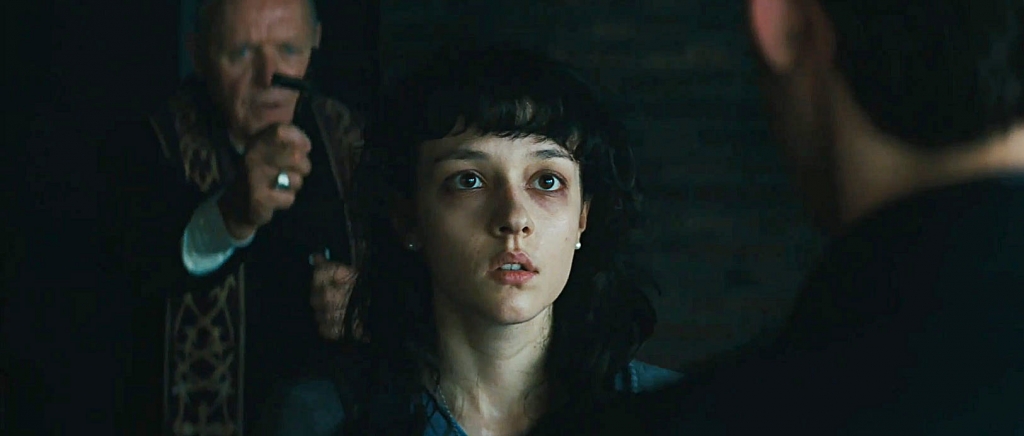
Recommended by Lex Vranick
The Rite is unique among supernatural horror stories.
Sure, there are plenty of exorcism movies out there. And, yes, many of them are based — or loosely based — on real life experiences. The Exorcist finds its roots with Roland Doe. The Exorcism of Emily Rose was inspired by Anneliese Michel. And The Rite itself was born from Matt Baglio’s 2009 non-fiction deep-dive into the education and training of Roman Catholic exorcists.
The Rite: The Making of a Modern Exorcist brought Baglio to the Pontifical Athenaeum Regina Apostolorum in Rome. Catholic priests and practitioners from around the world travel here to study subjects like theology, philosophy, ethics, religious sciences, and — for select clergymen — to learn the Rite of Exorcism. Here, Baglio met Father Gary Thomas, whose studies in Christian demonology and training in exorcism inspired producers to buy film rights before the book even hit shelves.
And here is where The Rite diverges from other supernatural stories.
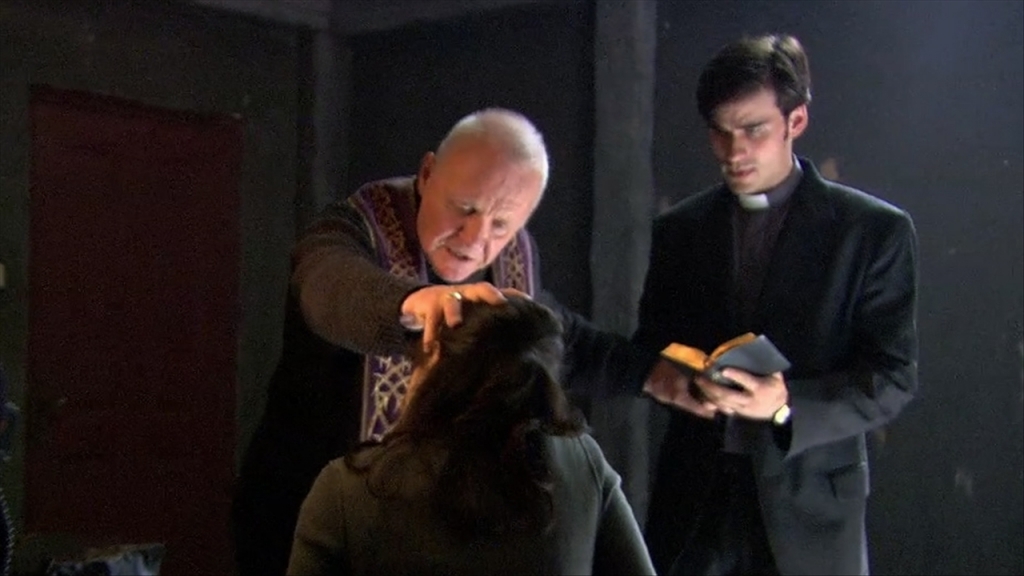
Where most tales begin with the possessed — with cursed objects and afflicted youths —The Rite begins in the Church. It follows a young priest (Colin O’Donoghue) on a journey of self-discovery as he travels to the Vatican and studies exorcism under the watchful eye of his mentor (Anthony Hopkins).
This is an exorcism story that brings religion to the forefront. Where priests in other films might find themselves sidelined as secondary characters, or may otherwise be thrown in without much regard for or exploration of their faith, The Rite makes the Church a central figure.
In a sense, faith becomes a character in and of itself. It lives and breathes in the imagery, the dialogue, the subject matter. The filmmakers brought Father Gary Thomas on as a consultant, and director Mikael Håfström even attended actual exorcisms to ensure accurate portrayals in the film.
The story is born from truth; true practices, true training, true faith.
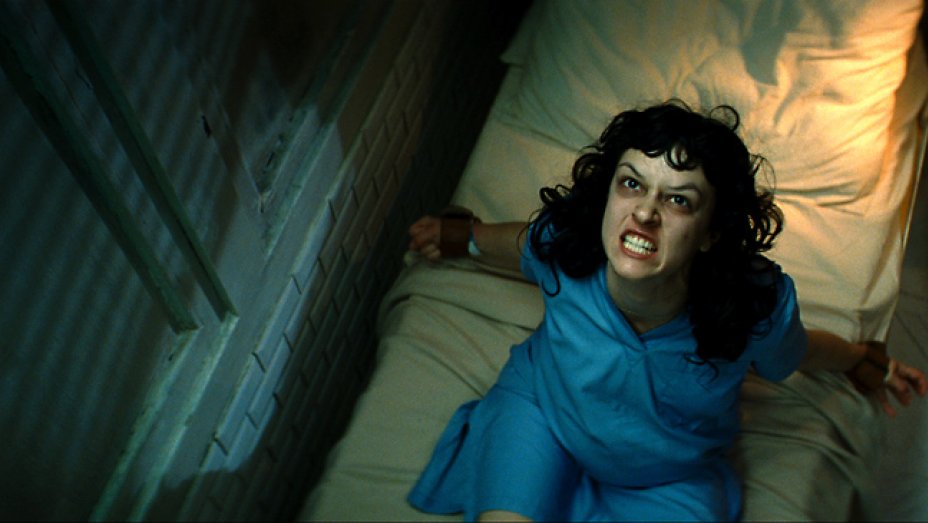
There are classic horror motifs, including possession hallmarks such as Latin speech, demonic voices in human hosts, and a victim restrained in a dark room. There are jump scares, and the film establishes its spooky tone right off the bat with an opening in a mortician’s workspace.
It’s a scary movie; but it’s also a coming-of-age movie, a story of a young man finding himself through his faith and the unique experiences he has within it.
THE BLACKCOAT’S DAUGHTER (2015)
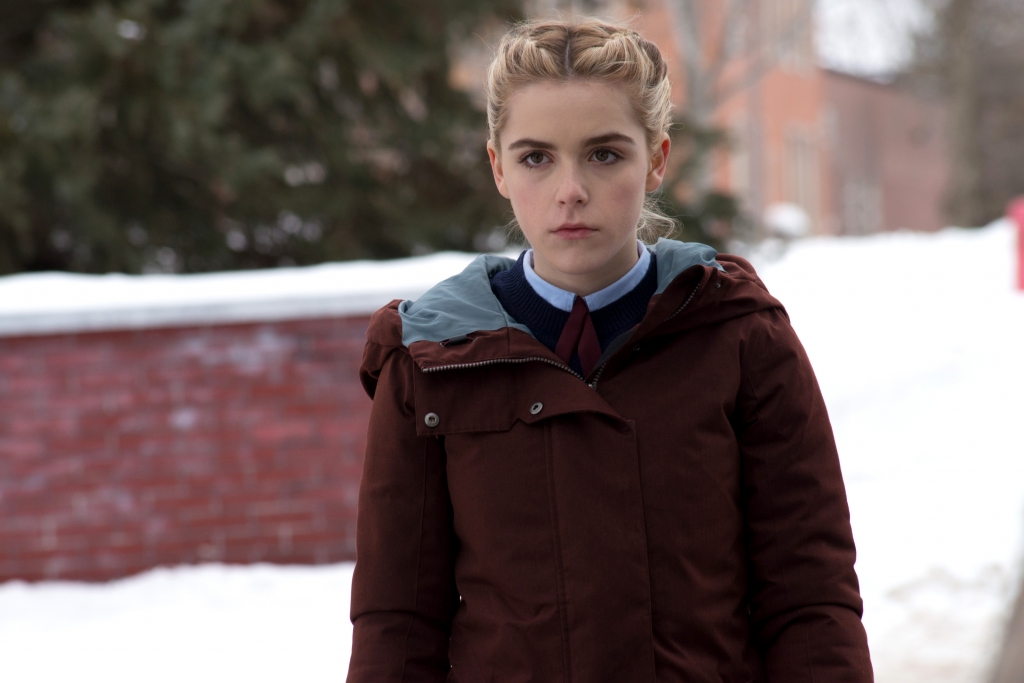
Recommended by Jerry Smith
In late 2015, I hopped on a plane and flew to the always lovely Austin, TX, to cover my favorite festival, Fantastic Fest. I had a full schedule of interviews, events and a well-planned amount of coverage that I was locked into. I knew which films I wanted to see and planned accordingly. A day or two into the festival, I woke bright and early with a massive hangover and walked from the Airbnb I was sharing with some fellow writers to a very early press screening of the then-titled February. I had zero expectations.
It would be a serious understatement to say I was ill prepared for what I was about to experience. The film, which would later be released as The Blackcoat’s Daughter, was one of the most memorable theatrical moments of my life.
As an individual who grew up forced into religion and faith, and as someone who came to terms with my lack of such faith, my interests have always lied within the sub-genre of religious horror.
The Blackcoat’s Daughter was a film that immediately became an all-time favorite.
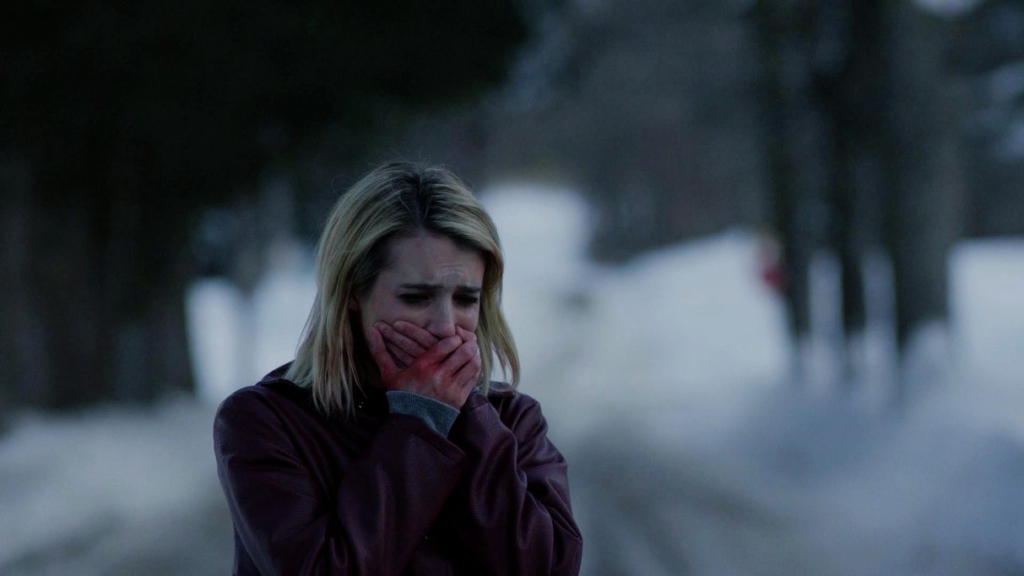
Following the cold winter break of a private boarding school and the interwoven stories of three young women, the film takes isolation, pain and innocence and weaves a slow burn tale of Satanic possession.
Sabrina’s Kieran Shipka plays the film’s protagonist/antagonist. Shipka gives such an enigmatic performance as a young woman succumbing to the temptations of the devil, as her isolation and loneliness takes her over.
Told in somewhat of a non-linear approach, the film also follows another woman, recently released from a mental health facility, making her way back somewhere. The woman (played by Emma Roberts), is mysterious and on edge, causing us to wonder where she’s been and why she’s so interested in getting to where she’s going.
The tension we feel while watching The Blackcoat’s Daughter causes us to anticipate that something big will inevitably go down and, when it does, it will be intense.
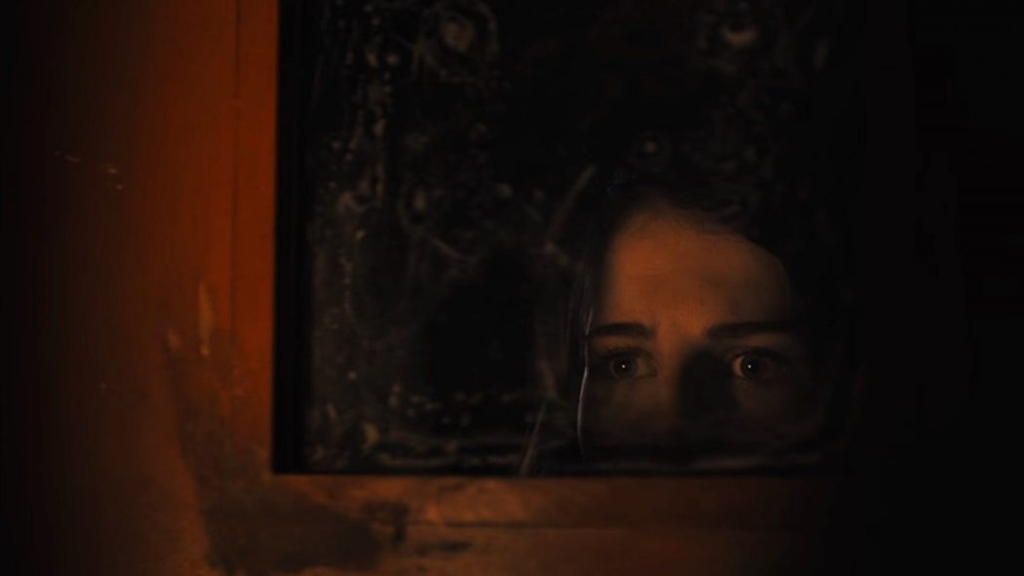
And the film does not disappoint on that promise, as one of the girls (Lucy Boynton) finds out she’s pregnant and is faced to confront a moral and ethical dilemma. This also serves to alienate Shipka’s character, who was already losing her grip.
When the film’s unsettling and eerie payoff arrives, the journey it took to get there feels well worth it. The sense of dread that runs throughout the film lands hard. In turn, director Oz Perkins gives horror fans a film that, in the impressive repertoire of film distributor A24, should be mentioned just as much as Hereditary or The Witch.
The Blackoat’s Daughter is a Satanic masterpiece and one of the most enjoyable films within the religious horror sub-genre.
THE DEVIL’S DOORWAY (2018)

Recommended by Jamie Alvey
Aislinn Clarke uses horror to uncover some of the forgotten unsavory deeds of the Catholic Church in her debut feature film The Devil’s Doorway. In Ireland, there were asylums known as Magdalene Laundries. Magdalene Laundries were a home for “fallen women” — a nice way of saying women who are shunned by society and ultimately punished for their sexuality. These women were often sex workers or those who became pregnant out of wedlock.
These asylums were run by the Catholic Church and unspeakable horrors took place. In 1993, a mass grave that contained 155 bodies of “Maggies” — women who were housed at the Laundries — was unearthed on the grounds of a convent. The discovery led to revelations about the horrid treatment of the women at the hands of the nuns.
Clarke uses one of the Magdalene Laundries as an apt backdrop for religious horror that takes a look at morality and how vulnerable women can suffer under women in positions of power.
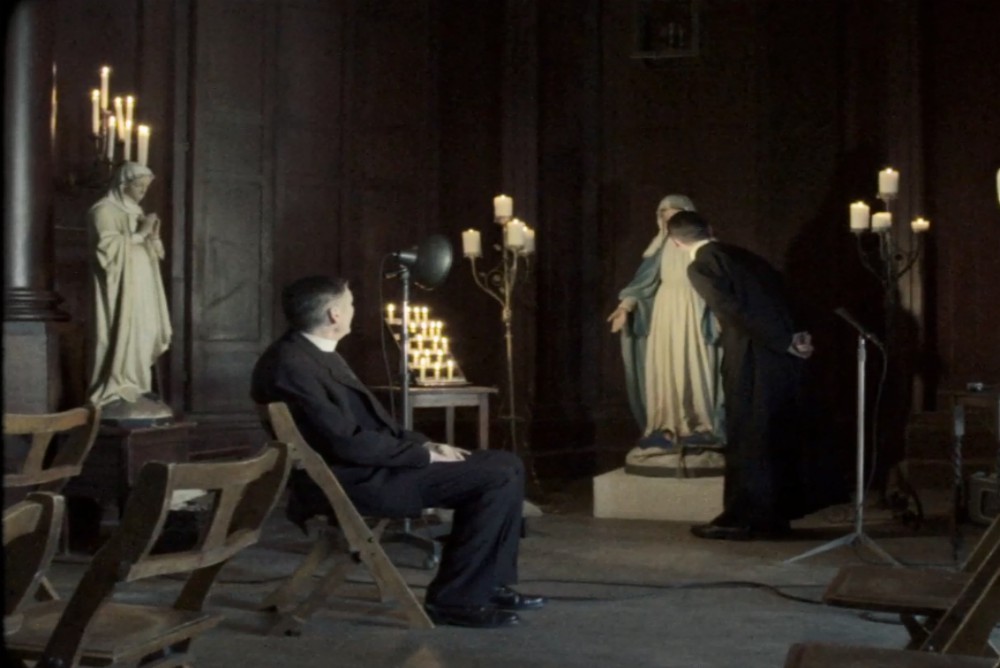
The film follows a young priest, Father John, and an old priest, Father Thomas, investigating a supposed miracle at one of these asylums. The miracle in question is a statue of The Virgin Mary crying blood. As Father Thomas and Father John slowly begin to unravel the mystery of the statue’s bloody tears, they uncover a pregnant teenager in squalid conditions named Kathleen. Kathleen is revealed to be a virgin and possessed by a demon. This knowledge leads to more sinister revelations.
While nuns are supposed to be brides of Christ who are filled with love and good will, the nuns in The Devil’s Doorway are far from that ideal. The Mother Superior of the convent is hateful and nasty and is often seen verbally abusing the Maggies.
The Maggies themselves are being held in the convent against their wills and being used for slave labor. There is no one to advocate for these women because the events that take place in the convent are secluded and deeply guarded.
The Mother Superior strives to keep Father Thomas and Father John in the dark about not only their mistreatment of Kathleen but also their general abuse of the Maggies as a whole.
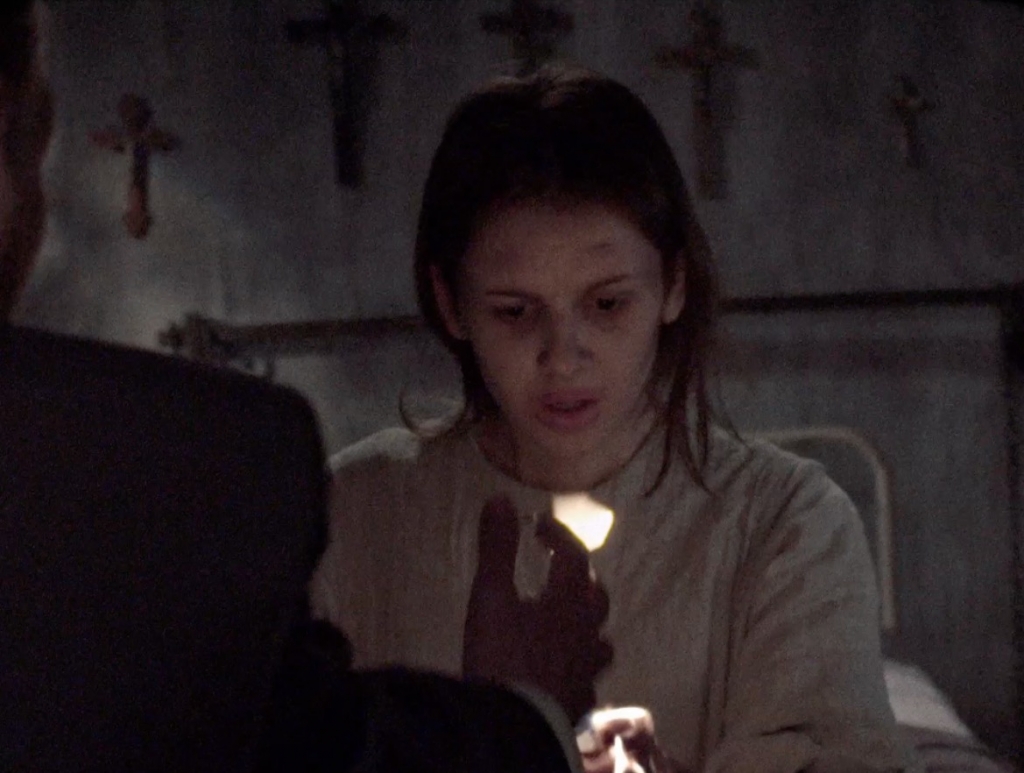
Clarke uses this to explore the idea of power dynamics within religious organizations. Those who are supposed to be merciful, just, and helpful are the ones that are using their power to prey on the vulnerable.
Aislinn Clarke is a brilliant filmmaker, and the way she handles these sensitive topics in The Devil’s Doorway is irrefutable proof of this. Clarke is the sort of bold and inventive voice that horror needs. She takes the old trope of the evil nun and turns it into a masterclass of social commentary.


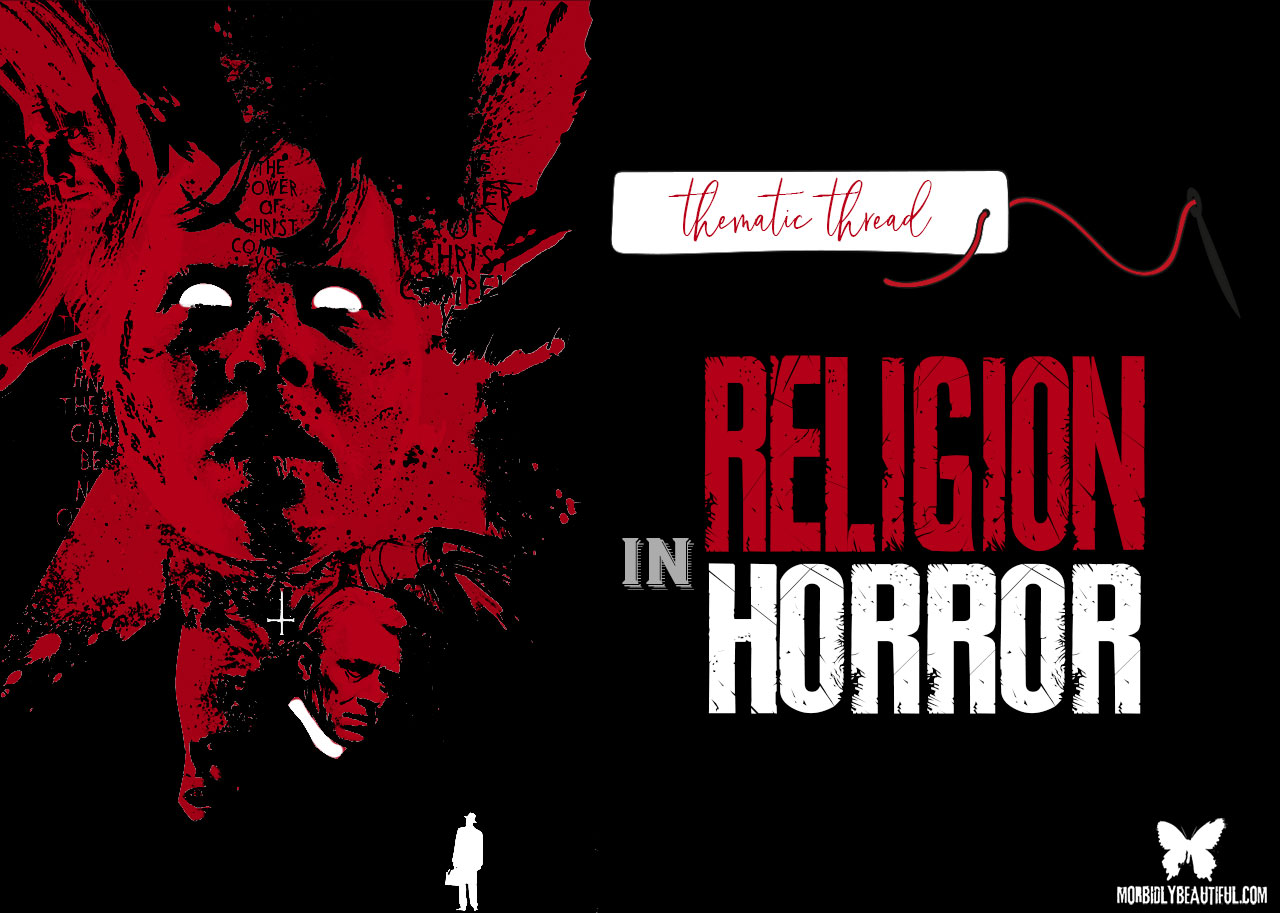
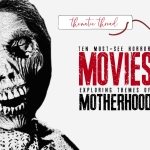
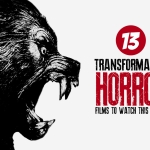
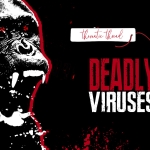













3 Comments
3 Records
Michael Williams wrote:
Awesome list. Gotta find The Devil’s Doorway now. Great to see Frailty on it. That movie does not get near enough love.
Laurent wrote:
Hi,Nice compilation.
you missed “The ninth gate” by Roman Polanski – meeting Satan through a protocol hidden in ancient books.
(great movie, great music – missing sectionsvon music …)
The Angry Princess wrote:
Thanks so much! Clearly, there is a ton of great religious horror we couldn’t get to in this list. Maybe it’s time for a part 2!